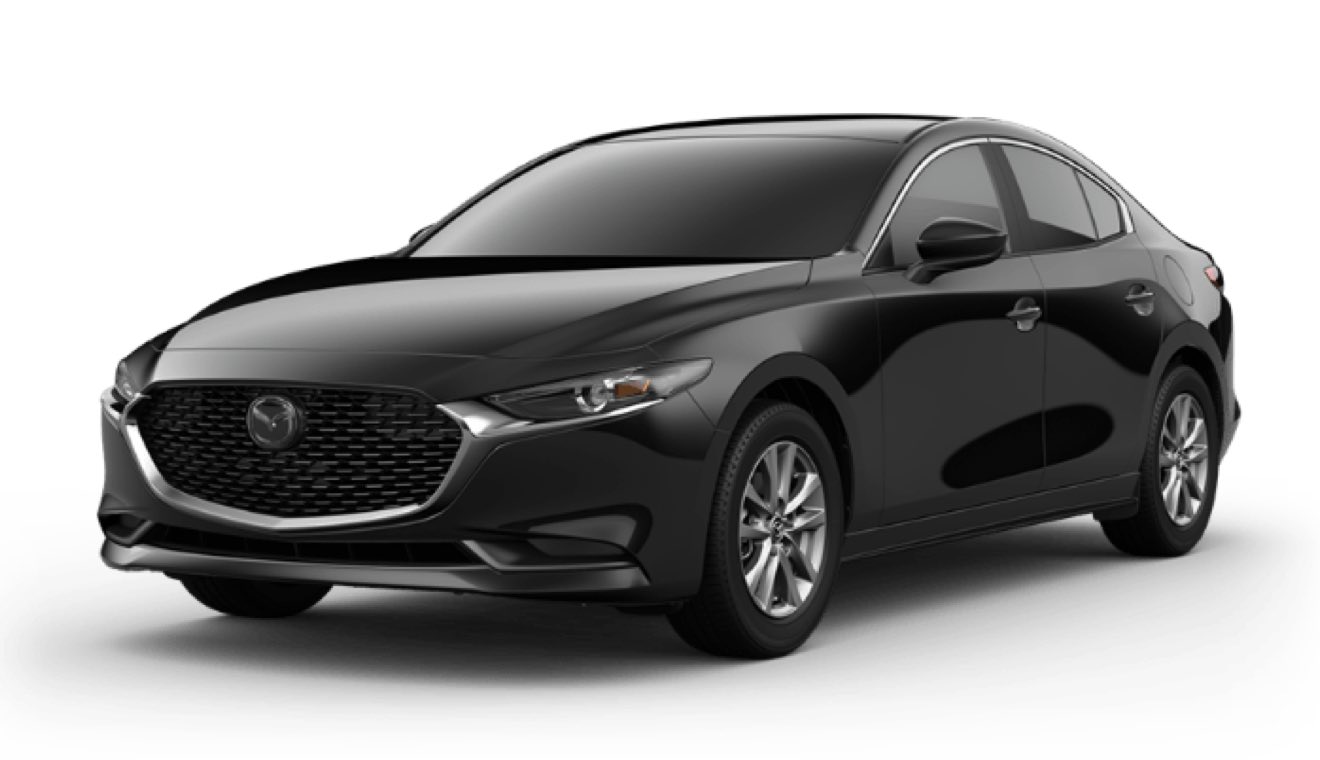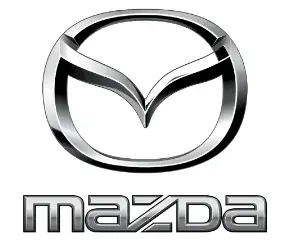2021 Mazda3 Radar Cruise Control User Manual
Introduction
Radar Cruise Control (RCC) is one of several cutting-edge features available on the outstanding 2021 Mazda3. RCC is a sophisticated driving aid system created to improve your driving experience’s comfort and safety. Utilizing radar technology, radar cruise control keeps your Mazda3 safely separated from the car in front of you. RCC automatically adjusts your car’s pace to fit the flow of traffic by continuously monitoring the distance and speed of the vehicle in front of you, making for a stress-free and comfortable driving experience. The Mazda3’s front grille houses a radar sensor, which the system uses to send and receive signals to gauge the distance and speed of the car in front of it.
It then determines the proper pace to maintain, making sure you keep a safe distance and stay away from abrupt braking or acceleration. The capability of Mazda’s Radar Cruise Control to adjust to various driving circumstances is one of its main advantages. RCC may automatically change the pace of your Mazda3 to keep a convenient and secure distance from the vehicle in front, whether you’re traveling on a highway or maneuvering through city traffic. This feature is especially helpful on long travels because it lessens driver fatigue and makes open-road motoring more enjoyable. Additionally, the Mazda3’s RCC includes a capability known as Stop & Go functionality. This indicates that your Mazda3 will stop completely if the vehicle in front of you does.
Radar Cruise Control
Mazda Radar Cruise Control (MRCC) (Manual Transmission)
The MRCC system is designed to maintain headway control*1 with a vehicle ahead according to your vehicle’s speed using a front radar sensor to detect the distance to the vehicle ahead and a preset vehicle speed without you having to use the accelerator or brake pedals. Headway Control: Control of the distance between your vehicle and the vehicle ahead detected by the MRCC system. Additionally, if your vehicle starts closing in on the vehicle ahead such as if the vehicle ahead brakes suddenly, a warning sound and a warning indication in the display are activated simultaneously to alert you to maintain a sufficient distance between the vehicles. Also refer to the following before using the MRCC.
- Front radar sensor
WARNING
Do not rely completely on the MRCC:
The MRCC system has detection limitations depending on the type of vehicle ahead and its conditions, the weather conditions, and the road conditions. Additionally, the system may be unable to decelerate sufficiently to avoid hitting the vehicle ahead if the vehicle ahead applies the brakes suddenly or another vehicle cuts into the driving lane, which could result in an accident. Always drive carefully and verify the surrounding conditions and depress the brake pedal or accelerator pedal while keeping a safe distance from vehicles ahead or on-coming vehicles.
Do not use the MRCC system in the following locations. Using the MRCC system at the following locations may result in an unexpected accident:
- General roads other than highways (Driving under these conditions using the MRCC system is not possible.)
- Roads with sharp curves and where vehicle traffic is heavy with insufficient space between vehicles, or roads where frequent and repetitive acceleration and deceleration occur (Driving under these conditions using the MRCC is not possible.)
- When entering and exiting interchanges, service areas, and parking areas of highways (If you exit a highway while headway control is in use, the vehicle ahead will no longer be tracked and your vehicle may accelerate to the set speed.)
- Slippery roads such as ice or snow-bound roads (Tires could spin causing you to lose vehicle control, or the stop hold control may not operate.)
- Long, descending slopes (to maintain distance between vehicles, the system automatically and continuously applies the brakes which could result in the loss of brake power.)
- Slopes with a steep gradient (The vehicle ahead may not be detected correctly.)
- Two-wheeled vehicles such as motorcycles or bicycles are ahead.
For safety purposes, switch the MRCC system off when it is not being used. Leaving the MRCC system turned on when it is not in use is dangerous as it could operate unexpectedly, resulting in an accident.
CAUTION
- Turn the system off when the vehicle is running on a chassis roller.
- If your vehicle is towed or you are towing something, switch the MRCC system off to prevent an unexpected operation.
NOTE
- The MRCC system does not detect the following as physical objects.
- Vehicles approaching in the opposite direction
- Pedestrians
- Stationary objects (stopped vehicles, obstructions)
- If a vehicle ahead is traveling at an extremely low speed, the system may not detect it correctly.
- If there is a structure on the road or an object (such as a monorail) at a low height off the ground in front of the vehicle, the system may operate. Therefore, do not use the MRCC.
- Do not use the MRCC system under conditions in which close proximity warnings are frequently activated.
- During headway control travel, the system accelerates and decelerates your vehicle in conjunction with the speed of the vehicle ahead. However, if it is necessary to accelerate for a lane change or if the vehicle ahead brakes suddenly causing you to close in on the vehicle rapidly, accelerate using the accelerator pedal or decelerate using the brake pedal depending on the conditions.
- While the MRCC system is in use, it does not cancel even if the shift lever is operated and any intended engine braking will not occur. If deceleration is required, lower the vehicle speed setting or depress the brake pedal.
- While braking by the MRCC control is operating, you might hear an operation sound, however, this does not indicate a problem.
- The brake lights turn on while braking by the MRCC control is operating, however, they may not turn on while the vehicle is on a down slope at the set vehicle speed or traveling at a constant speed and following a vehicle ahead.
- Stop the headway control function to switch the system to the cruise control function.
- Refer to the Settings section in the Mazda Connect Owner’s Manual.
Mazda Radar Cruise Control (MRCC) Display Indication
The MRCC setting status and operation conditions are indicated on the multi-information display and the active driving display.
A multi-information display (Basic display)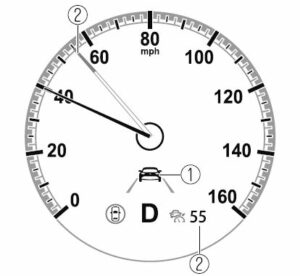
- Vehicle ahead display
- MRCC set vehicle speed
A multi-information display (i-ACTIVSENSE display)
- Vehicle ahead display
- MRCC set vehicle speed
Active driving display
- Vehicle ahead display
- MRCC set vehicle speed
If there is a problem with the MRCC system, a message is displayed on the multi-information display. Check the center display to verify the problem and then have your vehicle inspected by an Authorized Mazda Dealer.
Close Proximity Warning
If your vehicle rapidly closes in on the vehicle ahead because the vehicle ahead applies the brakes suddenly while you are traveling in headway control, the warning sound activates and the brake warning is indicated in the display. Always verify the safety of the surrounding area and depress the brake pedal while keeping a safe distance from the vehicle ahead. Additionally, keep a safe distance from the vehicles behind you.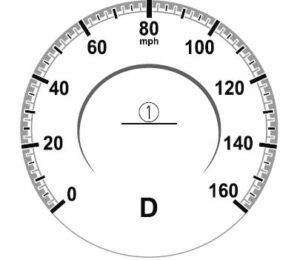 “Depress Brake Pedal” message is displayed
“Depress Brake Pedal” message is displayed
NOTE
In the following cases, the warnings and brakes may not operate even if your vehicle starts closing in on the vehicle ahead.
- You are driving your vehicle at the same speed as the vehicle ahead.
- Directly after the MRCC system has been set.
- Directly after the accelerator pedal is released.
- Another vehicle cuts into the driving lane in front of you.
Setting the System
The MRCC system operates when all of the following conditions are met.
- Vehicle speed is 30 km/h (19 mph) to 145 km/h (90 mph)
- The MRCC is turned on.
- The brake pedal is not depressed.
- The parking brake is released (Electric Parking Brake (EPB) indicator light is turned off).
- There is no problem with the DSC.
- All the doors are closed.
- The driver’s seat belt is fastened.
- The shift lever is in a position other than reverse (R) or neutral (N).
- The clutch pedal is not depressed.
Turning on the system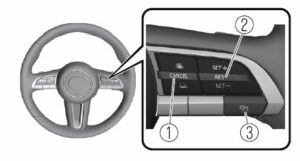
- CANCEL switch
- RES switch
- MRCC switch
When the MRCC switch is pressed once, the MRCC system turns on, and the MRCC standby indication (white) turns on and the vehicle speed and the distance between the vehicles while in headway control can be set. In addition, the MRCC system display indication is displayed on the multi-information display and the active driving display at the same time.
In addition, the MRCC system display indication is displayed on the multi-information display and the active driving display at the same time.
NOTE
If the ignition is switched off while the MRCC system is operating, the system will be operable when the ignition is switched ON the next time.
How to set the speed
Adjust the vehicle speed to the desired setting using the accelerator pedal and press the RES switch up (SET+) or down (SET-) to start headway control. The set speed is indicated on the display. At the same time, the MRCC standby indication (white) changes to the MRCC set indication (green).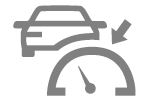
|
Travel status |
Indication on multi-information display | Indication on active driving dis- play (vehicles with active driving display) |
| During travel at constant speed | 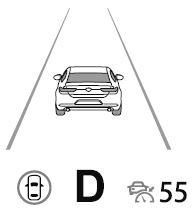 |
 |
| During travel under headway control | 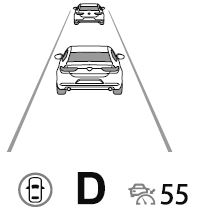 |
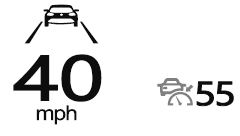 |
NOTE
- If a vehicle ahead is detected while traveling at a constant speed, the vehicle-ahead indication is displayed, and headway control is performed. Additionally, when a vehicle ahead is no longer detected, the vehicle-ahead indication turns off and the system switches back to travel at a constant speed.
- The lowest possible speed which can be set on the MRCC system is 30 km/h (19 mph).
- Headway control is not possible if the vehicle ahead is driving faster than your vehicle’s set speed. Adjust the system to the desired vehicle speed using the accelerator pedal.
How to set the distance between vehicles during headway control
The distance between vehicles can be set to 4 levels; Long, medium, short, and extremely short distance. The distance between vehicles is set to a shorter distance by pressing the CANCEL switch down. The distance between vehicles is set to a longer distance by pressing the CANCEL switch up.
| Distance-between-vehicles guideline(at 80 km/h (50 mph) vehicle speed) | Indication on multi-information display | Indication on active driving dis- play (vehicles with active driving display)*1 |
| Long (about 50 m (164 ft)) | 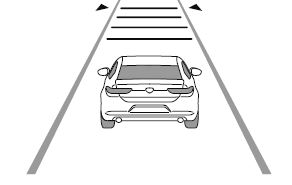 |
 |
| Medium (about 40 m (131 ft)) |  |
 |
| Short (about 30 m (98 ft)) |  |
 |
| Extremely short (about 25 m (82 ft)) | 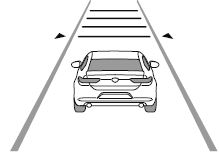 |
 |
Displays a pop-up image in the active driving display only when the driver operates the switch.
NOTE
- The distance between vehicles differs depending on the vehicle speed, and the slower the vehicle speed, the shorter the distance.
- When the ignition is switched to ACC or OFF and then the engine is started again, the system automatically sets the distance-between-vehicles to the previous setting.
Changing the Set Vehicle Speed
(To accelerate/decelerate using the RES switch) When the RES switch is pressed up (SET+), the vehicle accelerates and when the RES switch is pressed down (SET-), it decelerates.
- Press and release immediately: 1 km/h (1 mph)
- Press and hold: 10 km/h (5 mph)
(To increase speed using accelerator pedal)
Depress the accelerator pedal and press the RES switch up (SET+) or down (SET-) at the desired speed. If the switch is not operated, the system returns to the set speed after you release your foot from the accelerator pedal. NOTE The warnings and brake control do not operate while the accelerator pedal is depressed.
Canceling the system
When the following operations are performed, the MRCC system is canceled, and the MRCC set indication (green) switches to the MRCC standby indication (white) at the same time.
- The CANCEL switch is pressed.
- The brake pedal is depressed.
- The shift lever is in the reverse (R) position.
Under the following conditions, the MRCC cancel indication is displayed in the multi-information display and a single beep sound is heard.
- The DSC has operated.
- The Smart Brake Support (SBS) has operated.
- When traveling on a downslope for a long period of time.
- There is a problem with the system.
- The vehicle speed decreases to less than 25 km (16 mph).
- The shift lever is shifted to neutral (N) for a certain period of time.
- The clutch is depressed for a certain period of time.
- The engine stalls.
- The front radar sensor cannot detect target objects (during rain, fog, snow or other inclement weather conditions, or when the radiator grille is dirty).
- The parking brake is applied.
- Any of the doors is opened.
- The driver’s seat belt is unfastened.
- The operation frequency of the braking by the MRCC control is high.
Resuming control
If the MRCC system is canceled, you can resume control at the previously set speed by pressing the RES switch and after all of the operating conditions have been met. NOTE If the set speed is not indicated in the display, the control does not resume even if the RES switch is pressed.
Turning off the system
When the MRCC switch is pressed while the MRCC is operating, the MRCC turns off.
Shift-up/Shift-down Request Display
The shift-up or shift-down request display might be displayed while the MRCC is operating. When this occurs, shift gears because the gear position is not appropriate.
| Request | Indication on display |
| Shift up | Shift Up to a Higher Gear |
| Shift down | Shift Down to a Lower Gear |
NOTE
- If the gears are not shifted up even though the shift-up request indication is displayed, load will be applied to the engine and the MRCC might be automatically canceled or engine damage could occur.
- If the gears are not shifted down even though the shift-down request indication is displayed, the MRCC might be automatically canceled or engine stalling could occur.
Mazda Radar Cruise Control with Stop & Go function (MRCC with Stop & Go function)
The MRCC with Stop & Go function system is designed to maintain headway control*1 with a vehicle ahead according to your vehicle’s speed using a front radar sensor to detect the distance to the vehicle ahead and a preset vehicle speed without you having to use the accelerator or brake pedals.
- Headway Control:
Control of the distance between your vehicle and the vehicle ahead detected by the Mazda Radar Cruise Control (MRCC) system.
Additionally, if your vehicle starts closing in on the vehicle ahead such as if the vehicle ahead brakes suddenly, a warning sound and a warning indication in the display are activated simultaneously to alert you to maintain a sufficient distance between the vehicles. If the vehicle ahead stops while you are following behind it, your vehicle will stop and be held stopped automatically (stop hold control), and headway control will resume when you resume driving the vehicle such as by pressing the RES switch. Also, refer to the following before using the MRCC with Stop & Go function.
- AUTO HOLD
- Forward Sensing Camera (FSC)
- Front radar sensor
WARNING
Do not rely completely on the MRCC with Stop & Go function:
The MRCC with Stop & Go function system has detection limitations depending on the type of vehicle ahead and its conditions, the weather conditions, and the road conditions. Additionally, the system may be unable to decelerate sufficiently to avoid hitting the vehicle ahead if the vehicle ahead applies the brakes suddenly or another vehicle cuts into the driving lane in front of you, which could result in an accident. Always drive carefully and verify the surrounding conditions and depress the brake pedal or accelerator pedal while keeping a safe distance from vehicles ahead or on-coming vehicles. Do not use the MRCC with Stop & Go function system in the following locations. Using the MRCC with Stop & Go function system at the following locations may result in an unexpected accident:
- General roads other than highways (Driving under these conditions using the MRCC with Stop & Go function system is not possible.)
- Roads with sharp curves and where vehicle traffic is heavy with insufficient space between vehicles, or roads where frequent and repetitive acceleration and deceleration occur (Driving under these conditions using the MRCC with Stop & Go function is not possible.)
- When entering and exiting interchanges, service areas, and parking areas of highways (If you exit a highway while headway control is in use, the vehicle ahead will no longer be tracked and your vehicle may accelerate to the set speed.)
- Slippery roads such as ice or snow-bound roads (Tires could spin causing you to lose vehicle control, or the stop hold control may not operate.)
- Long, descending slopes (to maintain distance between vehicles, the system automatically and continuously applies the brakes which could result in the loss of brake power.)
- Slopes with a steep gradient (The vehicle ahead may not be detected correctly, your vehicle may slide while stopped by the stop hold control, and it may accelerate suddenly after it starts moving.)
- Two-wheeled vehicles such as motorcycles or bicycles are ahead.
For safety purposes, switch the MRCC with Stop & Go function system off when it is not being used. Leaving the MRCC with Stop & Go function system turned on when it is not in use is dangerous as it could operate unexpectedly, resulting in an accident.
Do not get out of the vehicle while the stop hold control is operating:
Getting out of the vehicle while the stop hold control is operating is dangerous as the vehicle may move unexpectedly and result in an accident. Before getting out of the vehicle, switch the MRCC with Stop & Go function system off, shift the selector lever to the P position, and apply the parking brake.
CAUTION
- If your vehicle is towed or you are towing something, switch the MRCC with Stop & Go function system off to prevent an unexpected operation.
- Turn the system off when the vehicle is running on a chassis roller.
NOTE
- The MRCC with Stop & Go function system does not detect the following as physical objects.
- Vehicles approaching in the opposite direction
- Pedestrians
- Stationary objects (stopped vehicles, obstructions)
- If a vehicle ahead is traveling at an extremely low speed, the system may not detect it correctly.
- If there is a structure on the road or an object (such as a monorail) at a low height off the ground in front of the vehicle, the system may operate. Therefore, do not use the MRCC with Stop & Go function.
- Do not use the MRCC with Stop & Go function system under conditions in which close proximity warnings are frequently activated.
- During headway control travel, the system accelerates and decelerates your vehicle in conjunction with the speed of the vehicle ahead. However, if it is necessary to accelerate for a lane change or if the vehicle ahead brakes suddenly causing you to close in on the vehicle rapidly, accelerate using the accelerator pedal or decelerate using the brake pedal depending on the conditions.
- While the MRCC with Stop & Go function system is in use, it does not cancel even if the selector lever is operated and any intended engine braking does not occur. If deceleration is required, lower the set speed or depress the brake pedal.
- While braking by the MRCC with Stop & Go function control is operating, you might hear an operation sound, however, this does not indicate a problem.
- The brake lights turn on while braking by the MRCC with Stop & Go function control is operating, however, they may not turn on while the vehicle is on a down slope at the set vehicle speed or traveling at a constant speed and following a vehicle ahead.
- Stop the headway control function to switch the system to the cruise control function. Refer to the Settings section in the Mazda Connect Owner’s Manual.
Mazda Radar Cruise Control with Stop & Go function (MRCC with Stop & Go function) Display Indication
The MRCC with Stop & Go function setting status and operation conditions are indicated on the multi-information display and the active driving display. Multi-information Display (Basic display)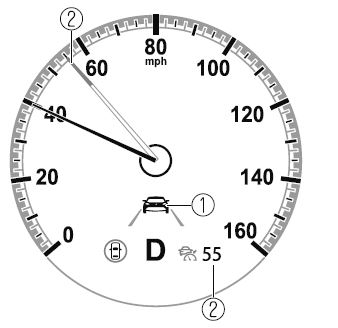
- Vehicle ahead display
- MRCC with Stop & Go function set vehicle speed
Multi-information Display (i-ACTIVSENSE display)
- Vehicle ahead display
- MRCC with Stop & Go function set vehicle speed
Active driving display
- Vehicle ahead display
- MRCC with Stop & Go function set vehicle speed
If there is a problem with the MRCC with Stop & Go function system, a message is displayed on the multi-information display. Check the center display to verify the problem and then have your vehicle inspected by an Authorized Mazda Dealer.
Close Proximity Warning
If your vehicle rapidly closes in on the vehicle ahead because the vehicle ahead applies the brakes suddenly while you are traveling in headway control, the warning sound activates and the brake warning is indicated in the display. Always verify the safety of the surrounding area and depress the brake pedal while keeping a safe distance from the vehicle ahead. Additionally, keep a safe distance from the vehicles behind you. “Depress Brake Pedal” message is displayed
“Depress Brake Pedal” message is displayed
NOTE
In the following cases, the warnings and brakes may not operate even if your vehicle starts closing in on the vehicle ahead.
- You are driving your vehicle at the same speed as the vehicle ahead.
- Directly after the MRCC with Stop & Go function system has been set.
- Directly after the accelerator pedal is released.
- Another vehicle cuts into the driving lane in front of you.
Setting the System
The MRCC with Stop & Go function system operates when all of the following conditions are met.
- Vehicle speed is 0 km/h (0 mph) to 145 km/h (90 mph)
- The MRCC with Stop & Go function is turned on.
- The brake pedal is not depressed.
- The parking brake is released (Electric Parking Brake (EPB) indicator light is turned off).
- There is no problem with the DSC.
- All the doors are closed.
- The driver’s seat belt is fastened.
- The selector lever is in the drive (D) position or manual (M) position (manual mode).
NOTE
- In the following cases, the MRCC with Stop & Go function system is canceled when the vehicle is traveling at 30 km/h (20 mph) or less and “Mazda Radar Cruise Control Disabled Under 30 km/h” is displayed in the multi-information display.
- The Forward Sensing Camera (FSC) cannot detect target objects (There is problem with the Forward Sensing Camera (FSC) or windshield is dirty).
- There is a problem with the stop hold control function.
- There is a problem with the Electric Parking Brake (EPB).
- It may not be possible to set the MRCC with Stop & Go function system directly after starting the engine, while the DSC operation is being checked.
Turning on the system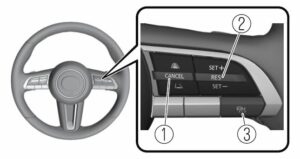
- CANCEL switch
- RES switch
- MRCC switch
When the MRCC switch is pressed once, the MRCC with Stop & Go function system turns on, and the MRCC with Stop & Go function standby indication (white) turns on and the vehicle speed and the distance between the vehicles while in headway control can be set.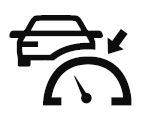 In addition, the MRCC with Stop & Go function system display indication is displayed on the multi-information display and the active driving display at the same time.
In addition, the MRCC with Stop & Go function system display indication is displayed on the multi-information display and the active driving display at the same time.
NOTE
If the ignition is switched off while the MRCC with Stop & Go function system is operating, the system will be operable when the ignition is switched ON the next time.
How to set the speed
Adjust the vehicle speed to the desired setting using the accelerator pedal and press the RES switch up (SET+) or down (SET-) to start headway control. The set speed is indicated on the display. At the same time, the MRCC standby indication (white) changes to the MRCC set indication (green).
|
Travel status |
Indication on multi-information display | Indication on active driving dis- play (vehicles with active driving display) |
| During travel at constant speed | 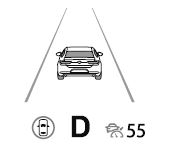 |
 |
| During travel under headway control | 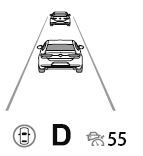 |
 |
NOTE
- If a vehicle ahead is detected while traveling at a constant speed, the vehicle-ahead indication is displayed and headway control is performed. Additionally, when a vehicle ahead is no longer detected, the vehicle-ahead indication turns off and the system switches back to travel at constant speed.
- The lowest possible speed which can be set on the MRCC with Stop & Go function system is 30 km/h (19 mph).
- Headway control is not possible if the vehicle ahead is driving faster than your vehicle’s set speed. Adjust the system to the desired vehicle speed using the accelerator pedal.
How to set the distance-between-vehicles during headway control The distance-between-vehicles can be set to 4 levels; Long, medium, short, and extremely short distance. The distance-between-vehicles is set to a shorter distance by pressing the CANCEL switch down. The distance-between-vehicles is set to a longer distance by pressing the CANCEL switch up.
| Distance-between-vehicles guideline(at 80 km/h (50 mph) vehicle speed) | Indication on multi-information display | Indication on active driving dis- play (vehicles with active driving display)*1 |
| Long (about 50 m (164 ft)) |  |
 |
| Medium (about 40 m (131 ft)) |  |
 |
| Short (about 30 m (98 ft)) |  |
 |
| Distance-between-vehicles guideline(at 80 km/h (50 mph) vehicle speed) | Indication on multi-information display | Indication on active driving dis- play (vehicles with active driving display)*1 |
| Extremely short (about 25 m (82 ft)) |  |
 |
Displays a pop-up image in the active driving display only when the driver operates the switch.
NOTE
- The distance-between-vehicles differs depending on the vehicle speed, and the slower the vehicle speed, the shorter the distance.
- When the ignition is switched to ACC or OFF and then the engine is started again, the system automatically sets the distance-between-vehicles to the previous setting.
Changing the Set Vehicle Speed
(To accelerate/decelerate using the RES switch) When the RES switch is pressed up (SET+), the vehicle accelerates and when the RES switch is pressed down (SET-), it decelerates.
- Press and release immediately: 1 km/h (1 mph)
- Press and hold: 10 km/h (5 mph)
(To increase speed using accelerator pedal) Depress the accelerator pedal and press the RES switch up (SET+) or down (SET-) at the desired speed. If the switch is not operated, the system returns to the set speed after you release your foot from the accelerator pedal.
NOTE
- The warnings and brake control do not operate while the accelerator pedal is depressed.
- The setting speed can be changed by operating the RES switch up (SET+) or down (SET-) during stop hold control.
Canceling the system
When the following operations are performed, the MRCC with Stop & Go function system is canceled, and the MRCC with Stop & Go function set indication (green) switches to the MRCC with Stop & Go function standby indication (white) at the same time.
- The CANCEL switch is pressed.
- The brake pedal is depressed.
- The selector lever is in the P (Park), N (Neutral), or R (Reverse) position.
Under the following conditions, the MRCC with Stop & Go function cancel indication is displayed in the multi-information display and a single beep sound is heard.
- The DSC has operated.
- The Smart Brake Support (SBS) has operated.
- When traveling on a downslope for a long period of time.
- There is a problem with the system.
- The parking brake is automatically applied during stop hold control.
- The front radar sensor cannot detect target objects (during rain, fog, snow or other inclement weather conditions, or when the radiator grille is dirty).
- The parking brake is applied.
- Any of the doors is opened.
- The driver’s seat belt is unfastened.
- The operation frequency of the braking by the MRCC with Stop & Go function control is high.
Resuming control
If the MRCC with Stop & Go function system is canceled, you can resume control at the previously set speed by pressing the RES switch and after all of the operation conditions have been met.
NOTE
If the set speed is not indicated in the display, the control does not resume even if the RES switch is pressed.
Turning off the system
When the MRCC switch is pressed while the MRCC is operating, the MRCC turns off.
Stop Hold Control
While in headway control using the MRCC with Stop & Go function system, your vehicle will stop when a vehicle ahead stops. When the vehicle is stopped and the stop hold control operates, the MRCC with Stop & Go function indicator light turns on. NOTE
NOTE
- If the MRCC with Stop & Go function system is canceled during stop hold control, the vehicle is held in its stopped position.
- The parking brake is automatically applied and the vehicle is held in its stopped position when 10 minutes have elapsed since the stop-hold control operated. At this time, the MRCC with Stop & Go function system is canceled.
- The brake lights turn on during stop-hold control.
To resume driving
After the vehicle ahead starts moving while your vehicle is stopped under stop hold control, press the RES switch or depress the accelerator pedal to cancel the stop hold control and resume driving.
NOTE
- When you resume driving by pressing the RES switch, your vehicle does not start moving until the distance between your vehicle and the vehicle ahead lengthens to the specified distance or farther.
- If the MRCC with Stop & Go function is temporarily canceled during stop hold control, you cannot resume driving by pressing the RES switch when there are no vehicles in front of your vehicle. Depress the accelerator pedal and resume driving the vehicle.
- If the vehicle ahead starts moving within 3 seconds after your vehicle is stopped by the stop hold control, headway control will resume even if you do not resume driving your vehicle, such as by depressing the accelerator pedal.
Resume driving information
If you do not resume driving within a few seconds after the vehicle ahead starts moving, the multi-information display vehicle-ahead indication flashes to urge the driver to resume driving. If you do not resume driving after the indicator light flashes, a sound is activated to urge you to resume driving.
Traffic Jam Assist (TJA)
The TJA is a system that consists of a headway control function and a steering assist function for reducing driver fatigue during traffic jams when driving on expressways or highways. This system performs headway control to maintain a constant distance between your vehicle and a vehicle ahead at a preset vehicle speed without you having to use the accelerator or brake pedal. Even further, with the steering assist function, when vehicle lane lines are detected, the function assists the driver in keeping the vehicle within the lane lines. If lane lines are not detected, the function provides the driver driving assistance in keeping the vehicle along the motion path with the vehicle ahead.
WARNING
Do not rely completely on TJA:
- The TJA is not an automated driving system. In addition, the functions have limitations. Do not rely completely on the system and always stay on course using the steering wheel.
- Set a vehicle speed within the speed limit according to the road conditions and the weather conditions.
- The TJA may not be able to detect a vehicle ahead depending on the type of vehicle ahead and its conditions, the weather conditions, and the road conditions. Additionally, the system might be unable to decelerate sufficiently if a vehicle ahead applies the brakes suddenly, another vehicle cuts into the driving lane, or the difference in vehicle speed between your vehicle and the vehicle ahead is larger, which could result in an accident. Check the surrounding conditions and always drive carefully while keeping a safe distance from vehicles ahead and on-coming vehicles.
For the purposes of safety, switch the TJA off when it is not being used. Leaving the TJA turned on when it is not in use is dangerous as it could operate unexpectedly, resulting in an accident.
Do not use the TJA under the following conditions. Otherwise, it may result in an accident.
- General roads other than expressways or highways (Driving under these conditions using the TJA is not possible.)
- Roads with sharp curves and where vehicle traffic is heavy with insufficient space between vehicles, or roads where frequent and repetitive acceleration and deceleration occur (Driving under these conditions using the TJA is not possible).
- When entering and exiting interchanges, service areas, and parking areas of expressways (If you exit an expressway while headway control is in use, the vehicle ahead will no longer be tracked and your vehicle may accelerate to the set speed).
- Slippery roads such as icy or snow-covered roads (Tires could spin causing you to lose vehicle control, or the stop hold control may not operate.)
- Long, descending slopes (to maintain distance between vehicles, the system automatically and continuously applies the brakes which could result in the loss of brake power.)
- Two-wheeled vehicles such as motorcycles or bicycles are ahead.
- (Automatic transmission vehicle) Slopes with a steep gradient (The vehicle ahead may not be detected correctly, your vehicle may slip while stopped by the stop hold control, or it may accelerate suddenly after it starts moving.)
- Driving under bad weather conditions (rain, fog, and snow).
- Tires of a different specified size are used, such as a temporary spare tire.
- Tires with insufficient tread are used.
- The tire pressures are not adjusted to the specified pressure.
- The vehicle is being used to tow a camper or boat trailer.
- Tire chains are used.
- The vehicle is driven on roads with lane lines other than white (yellow) lines, such as an expressway.
Do not get out of the vehicle while the stop hold control is operating.(Automatic transmission vehicle)
Getting out of the vehicle while the stop hold control is operating is dangerous as the vehicle may move unexpectedly and result in an accident. Before getting out of the vehicle, switch the TJA off, apply the parking brake, and then shift the selector lever to the P position.
CAUTION
Turn the system off when the vehicle is running on a chassis roller.
Heed the following cautions so that the TJA can operate normally.
- Turn the system off when the vehicle is running on a chassis roller.
- Do not modify the vehicle’s suspensions.
- Always use wheels of the specified size for the front and rear wheels. Consult an Authorized Mazda Dealer for tire replacement.
NOTE
- The headway control does not detect the following as physical objects.
- Vehicles approaching in the opposite direction
- Pedestrians
- Stationary objects (stopped vehicles, obstructions)
- If a vehicle ahead is traveling at an extremely low speed, the system may not detect it correctly.
- If there is a structure on the road or an object (such as a monorail) at a low height off the ground in front of the vehicle, the system may operate. Therefore, do not use the TJA.
- Do not use the TJA under conditions in which close proximity warnings are frequently activated.
- If it is necessary to accelerate for a lane change or the vehicle ahead brakes suddenly causing you to close in on the vehicle rapidly, accelerate using the accelerator pedal or decelerate using the brake pedal depending on the conditions.
- While the TJA is in use, any intended engine braking does not occur even if you shift the shift lever (manual transmission) or the selector lever
(automatic transmission). If deceleration is required, lower the vehicle speed setting or depress the brake pedal. - While braking by the TJA control is operating, you might hear an operation sound, however, this does not indicate a problem.
- The brake lights turn on while braking by the TJA control is operating, however, they may not turn on while the vehicle is on a down slope at the set vehicle speed or traveling at a constant speed and following a vehicle ahead.
- Under the following conditions, the TJA may not be able to detect white (yellow) lines or vehicles ahead correctly and the TJA may not operate normally.
- The forward sensing camera (FSC) cannot recognize the area in front of the vehicle due to soiling or fog.
- The white (yellow) lane lines are less visible because of dirt or paint flaking.
- White (yellow) lane lines or vehicles ahead are less visible because of bad weather (rain, fog, or snow).
- The vehicle is driven on a temporary lane or section with a closed lane resulting from construction where there might be multiple white (yellow) lane lines, or they are interrupted.
- The camera picks up an obscure line, such as a temporary line being used for construction, or because of shade, unmelted snow, or grooves filled with water.
- The road surface is wet and shiny after rain, or there are puddles on the road.
- Heavy luggage is loaded in the trunk/luggage compartment or on the rear seat causing the vehicle to tilt.
- A vehicle in front of your vehicle is running near a white (yellow) lane line making it less visible.
- The windshield is dirty or foggy.
- The vehicle is driven through an intersection, a junction, or a fork in the road.
- While white (yellow) lane lines cannot be detected due to road or weather conditions.
- The surrounding brightness suddenly changes such as when entering or exiting a tunnel.
- The illumination of the headlights is weakened because of dirt or the optical axis is deviated at night.
- Backlight is reflected off the road surface or the road surface is wet and shiny after rain.
- The shade of a guardrail parallel to a white (yellow) lane line is cast on the road.
- The width of a lane is excessively narrow or wide.
- The road is excessively uneven.
- The vehicle is shaken after hitting a road bump.
- There are various road markings or division lines (lane markings) of various shapes near an intersection.
- The area in front of the camera is soiled or an object that obstructs the field of view is installed.
- Exhaust gas from the vehicle in front, sand, snow, and water vapor rising from manholes and grating, and water splashed into the air.
- The surroundings are dark such as during the early evening or early morning.
- A vehicle ahead with a certain taillight shape.
- A vehicle ahead veers off course from your vehicle’s line of travel.
- A vehicle ahead is driving erratically.
- The vehicle is driven on roads with tight curves.
Headway control function
If a vehicle ahead is detected while traveling at a constant speed, the vehicle-ahead indication is displayed and headway control is performed.
Steering assist function
When lane lines are detected, the function assists the driver in keeping the vehicle within the lane lines. If lane lines are not detected, the function provides the driver driving assistance in keeping the vehicle along the motion path with the vehicle ahead.
NOTE
Steering assist limit warning
If the steering assist function cannot keep the vehicle within the lane lines while the steering assist function is operating, a warning sound is activated and a warning is displayed on the multi-information display to urge the driver to operate the steering wheel.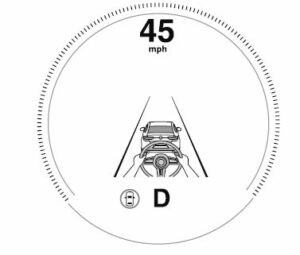
Traffic Jam Assist (TJA) Display Indication
The TJA setting status and operation conditions are indicated on the multi-information display or the active driving display.
A multi-information display (Basic display)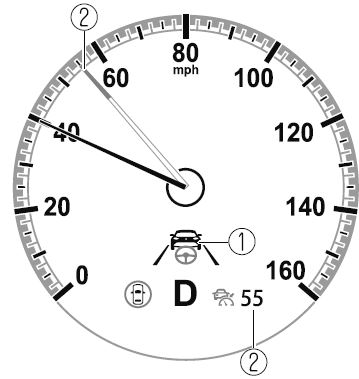
- Vehicle ahead display
- TJA set vehicle speed
A multi-information display (i-ACTIVSENSE display)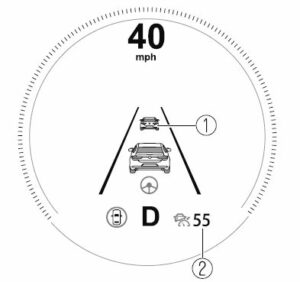
- Vehicle ahead display
- TJA set vehicle speed
Active driving display
- Vehicle ahead display
- TJA set vehicle speed
Steering assist function display
When the steering assist function operates, the steering assist operation display on the display changes from white to green.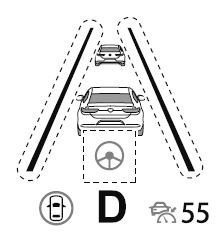
NOTE
You can view the multi-information display to check whether the steering assist is performing controls in conjunction with the traffic lane lines or a vehicle ahead.
Inactive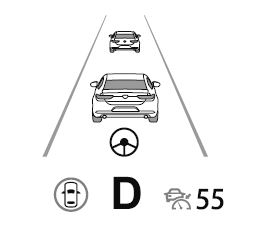
Active (vehicle ahead)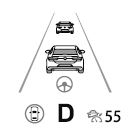
Active (lane line)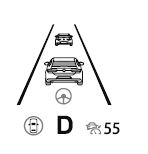
If there is a problem with the TJA, a message is displayed on the multi-information display. Check the details of the problem on the center display and then have your vehicle inspected by an Authorized Mazda Dealer.
Close Proximity Warning
If your vehicle rapidly closes in on the vehicle ahead while you are traveling under headway control, the warning sound is activated and the brake warning is indicated on the display. Keep a safe distance between your vehicle and a vehicle ahead.
1. “Depress Brake Pedal” message is displayed
NOTE
In the following cases, the warnings and brakes may not operate even if your vehicle starts closing in on the vehicle ahead.
- You are driving your vehicle at the same speed as the vehicle ahead.
- Directly after the TJA operates.
- Directly after the accelerator pedal is released.
- Another vehicle cuts into the driving lane in front of you.
Setting the System
Operation conditions
Headway control function
The TJA operates when all of the following conditions are met.
- (Automatic transmission vehicle)
- The vehicle speed is about 0 km/h (0 mph) to 145 km/h (90 mph).
- The selector lever is in the D or M position (manual mode).
- (Manual transmission vehicle)
- The vehicle speed is about 30 km/h (19 mph) to 145 km/h (90 mph).
- The shift lever is in a position other than the R or N position.
- The clutch pedal is not depressed.
- The TJA is operating.
- The headway control function of the Mazda Radar Cruise Control (MRCC) or Mazda Radar Cruise Control with Stop & Go function (MRCC with Stop & Go function) is set to operable (if it was set to inoperable, set it to operable using the personalization function).
- The brake pedal is not depressed.
- The parking brake is released (Electric Parking Brake (EPB) indicator light is turned off).
- There is no problem with the DSC.
- All the doors are closed.
- The driver’s seat belt is fastened.
NOTE
(Automatic transmission vehicle)
- Under the following conditions, the TJA cannot be used when the vehicle speed is 30 km/h (19 mph) or slower.
- There is a problem with the stop hold control function.
- There is a problem with the Electric Parking Brake (EPB).
- The TJA may not launch directly after the engine starts.
Steering assist function
The steering assist function operates when all of the following conditions are met.
- Your vehicle is moving and less than about 56 km/h (35 mph).
- White (yellow) lane lines on both sides are detected and you are driving near the center of the lane, or your vehicle detects a vehicle ahead.
- The steering wheel is not turned sharply.
- The turn signal lever is not operated.
- The headway control function is operating.
- (Manual transmission vehicle)
The vehicle speed is about 30 km/h (19 mph) or faster.
NOTE
The steering assist function operates so that the vehicle remains near the center of the driving lane, however, depending on conditions such as the road curvature, road slope and undulations, and vehicle speed, the function might not be able to keep the vehicle near the center of the driving lane.
Setting method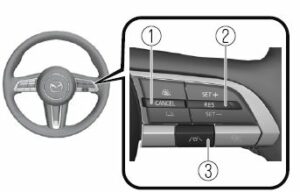
CANCEL switch
RES switch
TJA switch
- Press the TJA switch.
The TJA standby indication (white) turns on. In addition, the TJA display indication is displayed on the multi-information display at the same time.
- Adjust the vehicle speed to the desired setting using the accelerator pedal and press the RES switch up (SET+) or down (SET-) to start headway control. The set speed is indicated on the display. At the same time, the TJA standby indication (white) changes to the TJA set indication (green).
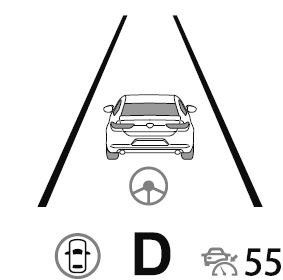
- The headway control is operable when all of the conditions for it to operate are met, or the steering assist function is operable when all of the conditions for it to operate are met.
NOTE
- If a vehicle ahead is detected while traveling at a constant speed, the vehicle-ahead indication is displayed and headway control is performed. Additionally, when a vehicle ahead is no longer detected, the vehicle-ahead indication turns off and the system switches back to travel at constant speed.
- Headway control is not possible if the vehicle ahead is driving faster than your vehicle’s set speed. Adjust the system to the desired vehicle speed using the accelerator pedal.
- When the ignition is switched OFF, the system status before it was turned off is maintained. For example, if the ignition is switched OFF with the TJA operable, the TJA remains operational the next time the ignition is switched ON.
- When the TJA switch is pressed while the Mazda Radar Cruise Control (MRCC) or Mazda Radar Cruise Control with Stop & Go function (MRCC with Stop & Go function) system is operating, the TJA operates. In addition, when the MRCC switch is pressed while the TJA is operating, the Mazda Radar Cruise Control (MRCC) or Mazda Radar Cruise Control with Stop & Go function (MRCC with Stop & Go function) system operates.
Changing the set vehicle speed
(To accelerate/decelerate using the RES switch)
When the RES switch is pressed up (SET+), the vehicle accelerates and when the RES switch is pressed down (SET-), it decelerates.
- Press and release immediately: 1 km/h (1 mph)
- Press and hold: 10 km/h (5 mph)
(To increase speed using accelerator pedal)
Depress the accelerator pedal and press the RES switch up (SET+) or down (SET-) at the desired speed. If the switch is not operated, the system returns to the set speed after you release your foot from the accelerator pedal.
NOTE
- The warnings and brake control do not operate while depressing the accelerator pedal.
- The lowest possible speed which can be set on the TJA is 30 km/h (19 mph).
- (Automatic transmission vehicle)
The vehicle speed setting can be changed by operating the RES switch during stop-hold control.
Changing the distance between vehicles during headway control
The distance between vehicles can be set to 4 levels; Long, medium, short, and extremely short distance.
The distance between vehicles is set to a shorter distance by pressing the CANCEL switch down. The distance between vehicles is set to a longer distance by pressing the CANCEL switch up.
| Distance-between-vehicles guideline
(at 80 km/h (50 mph) vehicle speed) |
Indication on display | |
| Indication on multi-information display | Indication on active driving dis- play (vehicles with active driving display)*1 | |
|
Long (about 50 m (164 ft)) |
|
|
|
Medium (about 40 m (131 ft)) |
|
|
|
Short (about 30 m (98 ft)) |
|
|
| Distance-between-vehicles guideline
(at 80 km/h (50 mph) vehicle speed) |
Indication on display | |
| Indication on the multi-information display | Indication on active driving dis- play (vehicles with active driving display)*1 | |
|
Extremely short (about 25 m (82 ft)) |
|
|
Displays a pop-up image when the CANCEL switch is operated.
NOTE
- The distance between vehicles differs depending on the vehicle speed, and the slower the vehicle speed, the shorter the distance.
- When the ignition is switched to ACC or OFF, the set distance between vehicles is taken over automatically even when the engine is started again.
The function is temporarily canceled
Headway control function
When the following operations are performed, the headway control function is temporarily canceled and the TJA set indication (green) changes to the TJA standby indication (white) at the same time.
- The CANCEL switch is pressed one time.
- The brake pedal is depressed.
- (Automatic transmission vehicle)
The selector lever is in the P, N, or R position. - (Manual transmission vehicle)
The shift lever is in the R position.
In the following cases, the TJA cancel indication is displayed and a sound is activated one time.
- The DSC has operated.
- The Smart Brake Support (SBS) has operated.
- The vehicle is driven on a downslope for a long time.
- There is a problem with the system.
- The front radar sensor cannot detect target objects (during rain, fog, snow or other inclement weather conditions, or when the radiator grille is dirty).
- The parking brake is applied.
- Any of the doors is opened.
- The driver’s seat belt is unfastened.
- The operation frequency of the braking by the TJA control is high.
- (Automatic transmission vehicle)
The parking brake is automatically applied during stop hold control. - (Manual transmission vehicle)
- The vehicle speed decreases below 25 km/h (15 mph).
- The shift lever is in the neutral position for a certain period of time.
- The clutch pedal is depressed for a certain period of time.
- The engine has stalled.
Steering assist function
If any of the following conditions occurs, the steering assist function is temporarily canceled.
- The headway control function is canceled.
- White (yellow) lane lines cannot be detected or a vehicle ahead cannot be recognized.
- Your vehicle speed is more than about 64 km/h (40 mph).
- The accelerator pedal is operated.
- The Lane-keep Assist System (LAS) has operated.
- The turn signal lever is operated.
- The vehicle is being driven on a sharp curve.
- The width of a lane is excessively narrow or wide.
- The vehicle crosses a lane line.
- The driver takes his/her hands off the steering wheel.
- The steering wheel is operated abruptly.
- There is a problem with the system.
- The temperature in the Forward Sensing Camera (FSC) is too high or too low.
- The windshield around the Forward Sensing Camera (FSC) is foggy.
- The windshield around the Forward Sensing Camera (FSC) is blocked by an obstruction, causing poor forward visibility.
NOTE
If you take your hands off the steering wheel (not holding the steering wheel), the warning sound is activated and an alert is indicated on the multi-information display and the active driving display.
Multi-information display
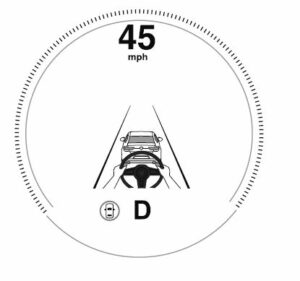
Active driving display (vehicles with active driving display)
If the steering wheel is held lightly, or depending on the road conditions, the system determines that you have released the steering wheel (not holding the steering wheel) even if you are holding it, and an alert is indicated on the multi-information display and the active driving display.
To resume operation
If the TJA is temporarily canceled, it will resume operation at the previously set speed by pressing the RES switch after all of the operation conditions have been met.
NOTE
- If the set speed is not indicated on the display, the system does not operate even if the RES switch is pressed.
- After the operation, the steering assist operation may not operate for a period of 5 seconds at the most until the lane lines are detected or a vehicle ahead is recognized.
Turning off
When the TJA switch is pressed while the TJA is operating, the TJA turns off.
Shift-up/Shift-down Request Display (Manual Transmission)
The shift-up or shift-down request display might be displayed while the TJA is operating. When this occurs, shift gears because the gear position is not appropriate.
| Request | Indication on display |
| Shift up | Shift Up to a Higher Gear |
| Shift down | Shift Down to a Lower Gear |
NOTE
- If the gears are not shifted up even though the shift-up request indication is displayed, load will be applied to the engine and the TJA might be automatically canceled or engine damage could occur.
- If the gears are not shifted down even though the shift-down request indication is displayed, the TJA might be automatically canceled or engine stalling could occur.
Stop Hold Control (Automatic Transmission)
While in headway control using the TJA, your vehicle will stop when a vehicle ahead stops. When the vehicle is stopped and the stop hold control operates, the TJA indicator light turns on.
NOTE
- Even if the TJA is temporarily canceled during stop-hold control, the vehicle is held in its stopped position.
- The parking brake is automatically applied and the vehicle is held in its stopped position when 10 minutes or longer have passed since the stop-hold control operated. When this occurs, the TJA is temporarily canceled.
- The brake lights turn on during stop-hold control.
To resume driving after the vehicle ahead starts moving while your vehicle is stopped under stop-hold control, press the RES switch or depress the accelerator pedal to cancel the stop-hold control and start driving.
NOTE
- When you resume driving by pressing the RES switch, your vehicle does not start moving until the distance between your vehicle and the vehicle ahead lengthens to the specific distance or farther.
- If the TJA is temporarily canceled, depress the accelerator pedal and start driving the vehicle. If the TJA is temporarily canceled, you cannot resume driving by pressing the RES switch when there are no vehicles in front of your vehicle.
- If the vehicle ahead starts moving within 3 seconds after your vehicle is stopped by the stop hold control, headway control will continue even if you do not resume driving your vehicle, such as by depressing the accelerator pedal.
Vehicle departure information
If you do not resume driving within a few seconds after the vehicle ahead starts moving during stop hold control, the multi-information display
vehicle-ahead indication flashes to urge the driver to resume driving. If you do not resume driving after the indicator light flashes, a sound is activated to urge you to resume driving.
Lane-keep Assist
Lane-keep Assist System (LAS)
The LAS provides steering assistance to help the driver stay within the vehicle lane if the vehicle might be deviating. The forward sensing camera (FSC) detects the white lines (yellow lines) of the vehicle lane in which the vehicle is traveling and if the system determines that the vehicle may deviate from its lane, it operates the electric power steering to assist the driver’s steering operation. The system also alerts the driver by displaying an alert on the multi-information display. Use the system when you drive the vehicle on roads with white (yellow) lines such as expressways and highways.
The LAS provides steering assistance to help the driver stay within the vehicle lane if the vehicle might be deviating. The forward sensing camera (FSC) detects the white lines (yellow lines) of the vehicle lane in which the vehicle is traveling and if the system determines that the vehicle may deviate from its lane, it operates the electric power steering to assist the driver’s steering operation. The system also alerts the driver by displaying an alert on the multi-information display. Use the system when you drive the vehicle on roads with white (yellow) lines such as expressways and highways.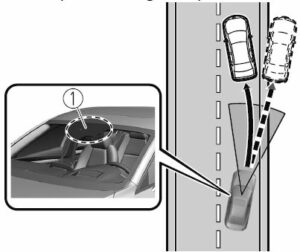
WARNING
Do not rely completely on the LAS:
- The LAS is not an automated driving system. In addition, the system is not designed to compensate for a driver’s lack of caution, and over-reliance on the system could lead to an accident.
- The functions of the LAS have limitations. Always stay on course using the steering wheel and drive with care.
- Do not use the LAS under the following circumstances, otherwise it may result in an accident.
- The vehicle is driven on slippery roads such as icy or snow-covered roads, and unpaved roads.
- Tires of a different specified size are used, such as a temporary spare tire.
- Tires with insufficient tread are used.
- The tire pressures are not adjusted to the specified pressure.
- The vehicle is being used to tow a camper or boat trailer.
- Tire chains are used.
- The vehicle is driven on roads with lane lines other than white (yellow) lines, such as an expressway.
CAUTION
Heed the following cautions so that the LAS can operate normally.
- Do not modify the vehicle’s suspensions.
- Always use tires of the specified type and size for the front and rear wheels. Consult an Authorized Mazda Dealer for tire replacement.
- NOTE
The system may not operate normally under the following conditions. - The white (yellow) lane lines are less visible because of dirt or paint flaking.
- White (yellow) lane lines are less visible because of bad weather (rain, fog, or snow).
- The vehicle is driven on a temporary lane or section with a closed lane resulting from construction where there might be multiple white
(yellow) lane lines, or they are interrupted. - The camera picks up an obscure line, such as a temporary line being used for construction, or because of shade, unbelted snow, or grooves filled with water.
- The surrounding brightness suddenly changes such as when entering or exiting a tunnel.
- Back-light is reflected off the road surface.
- The road surface is wet and shiny after rain, or there are puddles on the road.
- The width of a lane is excessively narrow.
- The vehicle is driven on roads with tight curves.
- Heavy luggage is loaded in the trunk/luggage compartment or on the rear seat causing the vehicle to tilt.
- The vehicle is driven through a fork in the road or a junction.
- The shade of a guardrail parallel to a white (yellow) lane line is cast on the road.
- The illumination of the headlights is weakened because of dirt or the optical axis is deviated at night.
- The road is excessively uneven.
- The vehicle is shaken after hitting a road bump.
- A vehicle in front of your vehicle is running near a white (yellow) lane line making it less visible.
The windshield is dirty or foggy. - Strong light is directed from the front of the vehicle (such as sunlight, or headlights (high-beam) of on-coming vehicles).
System Operation
When the ignition is switched ON, the i-ACTIVSENSE status symbol (warning/risk avoidance support system) (white) turns on and the system goes on standby.
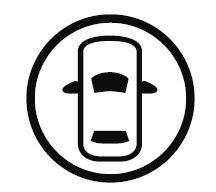
NOTE
If the i-ACTIVSENSE status symbol (warning/risk avoidance support system) (white) does not turn on, the system is canceled using the
i-ACTIVSENSE OFF switch or the personalization feature.
Operation conditions
When all of the following conditions are met, the i-ACTIVSENSE status symbol (warning/risk avoidance support system) on the multi-information display changes from white to green and the system becomes operational.
- The vehicle speed is about 64 km/h (40 mph) or faster.
- The system detects white (yellow) lane lines.
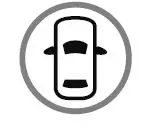
NOTE
When the system does not detect a white (yellow) lane line on one side only, the system does not operate on the side that is not being detected.
When temporarily canceling the system
The LAS goes on standby in the following cases: The LAS operation is automatically restored when the system’s operation conditions are met.
- The system cannot detect white (yellow) lane lines.
- The vehicle speed is less than about 56 km/h (35 mph).
- The turn signal lever is operated.
- The accelerator pedal is depressed abruptly.
- The TCS/DSC is operating.
- The TCS/DSC is turned off.
- The steering wheel is operated.
- The brake pedal is operated.
The function is temporarily stopped.
The LAS stops functioning in the following cases:
- The temperature in the forward sensing camera (FSC) is too high or too low.
- The windshield around the forward sensing camera (FSC) is foggy.
- The windshield around the forward sensing camera (FSC) is blocked by an obstruction, causing poor forward visibility.
- Strong light (such as sunlight, or headlights (high-beam) of on-coming vehicles) is directed at the forward sensing camera (FSC).
System malfunction
If there is a problem with the system, the i-ACTIVSENSE status symbol (warning/risk avoidance support system) (white) and the i-ACTIVSENSE warning indication/warning light on the multi-information display turns on and a message is indicated. Refer to i-ACTIVSENSE Status Symbol (Warning/Risk Avoidance Support System).
Steering Wheel Operation Assist
When the system determines that the vehicle might be deviating from its lane, the steering wheel operation assist operates. The system notifies the driver that it provided steering wheel operation assistance on the multi-information display and the active driving display. Multi-information display (Basic display)
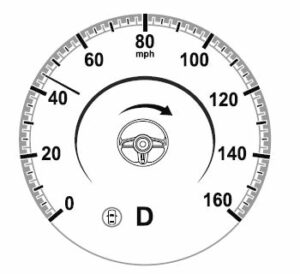
NOTE
- When the driver operates the steering wheel while the steering wheel operation assist is operating, the steering wheel operation assistance is canceled.
- System Canceling
The LAS can be set to inoperable. - (If only the LAS is turned off)
Refer to the Settings section in the Mazda Connect Owner’s Manual.
(If the LAS is turned off by operating the i-ACTIVSENSE OFF switch) Refer to i-ACTIVSENSE OFF Switch .
NOTE
If the ignition is switched OFF while you have canceled the system using the i-ACTIVSENSE OFF switch, the system is automatically enabled the next time the ignition is switched ON. However, if the system is canceled using the personalization features, the system is not automatically enabled.
Smart Brake Support
The SBS is a system designed to detect target objects using sensors and cameras equipped on the vehicle, and to reduce damage in the event of a collision by operating the brake control if there is the possibility of your vehicle colliding with a target object. One part of the SBS functions when you are driving forward and the other part functions when you are driving in reverse.
- Refer to Forward drive detection.
- Refer to Reverse drive detection.
Forward drive detection
When you are driving forward, the following functions of the Smart Brake Support (SBS) operate.
- Forward detection function
WARNING
Do not rely completely on the SBS:
The SBS is only designed to reduce damage in the event of a collision. The system may not operate normally depending on the target object, weather conditions, or traffic conditions. Over reliance on the system leading to the accelerator pedal or brake pedal being mistakenly operated could result in an accident.
CAUTION
In the following cases, turn the SBS off to prevent a misoperation.
- The vehicle is being towed or towing another vehicle.
- The vehicle is driven on rough roads such as in areas where there is grass and foliage or off-road.
NOTE
During the SBS brake control, the brake pedal may move rearward or become stiff. The brakes are operating, but continue to depress the brake pedal.
Forward detection function
The forward detection function is designed to reduce damage in the event of a collision with target objects at the front. The forward detection function detects target objects (vehicles ahead, pedestrians, and bicycles) using the front radar sensor and the Forward Sensing Camera (FSC). If there is a possibility of your vehicle colliding with a target object at the front, you are notified of possible danger by a warning sound and a warning indication on the display. Furthermore, if the possibility of a collision increases, the brake control is performed to reduce damage in the event of a collision. In addition, when the driver depresses the brake pedal, the brakes are applied firmly and quickly to assist.
(Vehicles with Driver Monitoring (DM))
If the system determines that the driver is not paying attention to the road, it activates the collision warning earlier than normal.
Operation conditions
The forward detection function operates when all of the following conditions are met.
- The ignition is switched ON.
- The SBS is on.
- (Object is vehicle ahead)
The vehicle speed is about 4 km/h (3 mph) or higher. - (Object is a pedestrian or bicycle) The vehicle speed is between about 10 and 80 km/h (6.3 to 49 mph).
- The DSC does not operate.
NOTE
- When any of the following conditions is met, the forward detection function may not operate.
- If there is the possibility of hitting only a part of a vehicle or obstruction ahead.
- You are driving your vehicle at the same speed as the vehicle ahead.
- When the driver deliberately performs driving operations N(accelerator operation, steering wheel operation).
- The accelerator pedal is depressed abruptly.
- The brake pedal is depressed.
- The steering wheel is being operated.
- (Automatic transmission)
The selector lever is being shifted. - The turn signal lever is being operated.
- Warnings and messages, such as a dirty windshield, related to the Forward Sensing Camera (FSC) or front radar sensor are being displayed on the multi-information display.
- When any of the following conditions is met, the forward detection function may operate.
- There is an object in the road at the entrance to a curve (including guardrails and snow banks).
- Passing an approaching vehicle while rounding a curve.
- When crossing a narrow bridge, going under a low overhang, or passing through a narrow gate, a car washing machine, or tunnel.
- When passing through a toll gate.
- When entering an underground parking area.
- There is a metal object, bump, or a protruding object on the road.
- If you suddenly come close to a vehicle ahead.
- An animal, wall, or standing tree is detected.
- While the system is operating, the driver is notified by the multi-information display and the active driving display.
- If a malfunction is detected or the system temporarily stops the function due to dirt on the sensors or cameras, the i-ACTIVSENSE warning light turns on and a message is displayed on the multi-information display.
- (Manual transmission)
On a manual transmission vehicle, the engine stops if the clutch pedal is not depressed when the vehicle is stopped by the SBS brake operation. - If the vehicle is stopped by the SBS brake operation and the brake pedal is not depressed, the SBS brake is automatically released after about 2 seconds.
Collision warning
If there is the possibility of your vehicle colliding with a target object at the front, the warning sound is activated continuously and a warning is 4-170 *Some models displayed on the multi-information display and the active driving display. Multi-information display.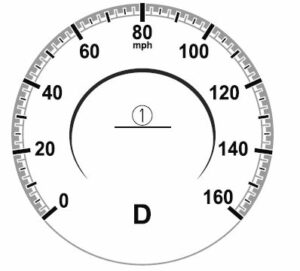
- “BRAKE!” message is displayed Active driving display*

- “BRAKE!” message is displayed N
NOTE
- During brake control and brake assist operation, the collision warning sound is activated intermittently.
- The operation distance and volume of the collision warning can be changed.
Refer to the Settings section in the Mazda Connect Owner’s Manual.
Reverse drive detection
When you are driving in reverse, the following functions of the Smart Brake Support (SBS) operate.
- Rearward detection function
- Rear crossing
WARNING
Do not rely completely on the SBS: The SBS is only designed to reduce damage in the event of a collision. Over reliance on the system leading to the accelerator pedal or brake pedal being mistakenly operated could result in an accident.
Heed the following cautions so that the SBS can operate normally:
- Do not apply stickers (including transparent stickers) to the areas around the rear side radar sensors and the rear ultrasonic sensors. Otherwise, a rear side radar sensor and a rear ultrasonic sensor may not be able to detect vehicles and obstructions correctly which could result in an accident.
- Do not disassemble the rear side radar sensors and rear ultrasonic sensors.
- If you recognize scratches around the rear side radar sensors and rear ultrasonic sensors, stop using the SBS immediately and always have the vehicle inspected by an Authorized Mazda Dealer.
Consult an Authorized Mazda Dealer for rear bumper removal/installation.
Do not modify the suspension:
If the vehicle height or inclination is changed, the SBS may not operate correctly because it cannot detect obstructions correctly.
Do not hit the rear side radar sensors and rear ultrasonic sensors forcefully:
When washing the vehicle, do not spray highly pressurized water against the rear side radar sensors and the rear ultrasonic sensors, or rub them strongly. In addition, do not hit the rear bumper forcefully when loading and unloading cargo. Otherwise, the system will be unable to detect obstructions correctly and the SBS may not operate normally.
CAUTION
- In the following cases, turn the SBS off to prevent a mis-operation.
- A trailer is pulled or an accessory such as a bicycle carrier is installed to the rear of the vehicle.
- The vehicle is driven on rough roads such as in areas where there is grass and foliage or off-road. Refer to Stopping the Smart Brake Support (SBS) System Operation on page 4-176.
- Always use tires for all wheels that are of the specified size, and the same manufacture, brand, and tread pattern. In addition, do not use tires with significantly different wear patterns on the same vehicle. If such improper tires are used, the SBS may not operate normally.
NOTE
During the SBS brake control, the brake pedal may move rearward or become stiff. The brakes are operating, but continue to depress the brake pedal.
Rearward detection function
The rearward detection function is designed to reduce damage in the event of a collision with a target object when reversing.
The rearward detection function detects obstructions using the rear ultrasonic sensors. In addition, if there is the possibility of your vehicle colliding with a target object at the rear while you are driving in reverse, you are notified of possible danger by a warning sound and a warning indication on the display. Furthermore, if the possibility of a collision increases, brake control is performed to reduce damage in the event of a collision.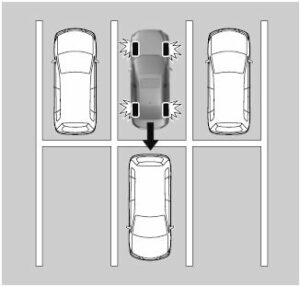
WARNING
Always check the surrounding area visually when reversing the vehicle:
The operation of the rearward detection function has certain limitations. Therefore, the function might not operate or it might be delayed even if there is a target object at the rear of your vehicle. Always make it your responsibility as a driver to check the rear.
Operation conditions
The rearward detection function operates when all of the following conditions are met.
- The engine is running.
- The SBS is on.
- (Automatic transmission)
- The selector lever is in the R position.
- (Manual transmission)
The shift lever is in the R position. - The vehicle speed is about 2 km/h (2 mph) to 8 km/h (4 mph).
- There is no problem with the DSC.
NOTE
- When any of the following conditions is met, the rearward detection function may not operate.
- Directly after the engine starts.
- The height of the obstruction is low such as low walls or trucks with low loading platforms.
- The height of the obstruction is high such as trucks with high loading platforms.
- The obstruction is not as large as a vehicle or wall.
- The obstruction is thin such as a signpost.
- The surface of the obstruction is not pointed vertically relative to your vehicle.
- The obstruction is soft such as a hanging curtain or snow stuck to a vehicle.
‘The obstruction is shaped irregularly.
‘The obstruction is extremely close.
‘When any of the following conditions is met, the rearward detection function may not operate normally.
‘Snow, ice, or mud adheres to the area around a rear ultrasonic sensor.- The vehicle posture is unstable due to sudden operation of the steering wheel, accelerator pedal, or brake pedal.
- There is another obstruction near one obstruction.
- During inclement weather such as rain, fog, and snow.
- High or low humidity.
- High or low temperatures.
- Strong winds.
- The path of travel is not flat.
- Heavy luggage is loaded in the luggage compartment or on the rear seat and the vehicle is tilted.
- Objects such as a wireless antenna, fog light, or illuminated license plate is installed near a rear ultrasonic sensor.
- The orientation of a rear ultrasonic sensor has deviated for reasons such as a collision.
- The vehicle is affected by other sound waves such as the horn, engine noise, or rear ultrasonic sensor of another vehicle.
- When any of the following conditions is met, the rearward detection function may operate.
- Reversing towards a steep ascending slope.
- There are grating, wheel blocks, a road curb, or a bump.
- There is a hanging curtain or railroad crossing gate.
- Reversing near objects such as foliage, barriers, vehicles, walls, or fences.
- The vehicle is driven on rough roads such as in areas where there is grass and foliage or off-road.
- When reversing through low gates, narrow gates, car washing machines, tunnels, or into a mechanical parking garage.
- A towing bar is installed or a trailer is connected.
- (Manual transmission)
- On a manual transmission vehicle, the engine stops if the clutch pedal is not depressed when the vehicle is stopped by the SBS brake operation.
- If the vehicle is stopped by the SBS brake operation and the brake pedal is not depressed, the SBS brake is automatically released after about 2 seconds.
Collision warning
If there is the possibility of your vehicle colliding with a vehicle approaching from the rear on the left or right, or from the rear while you are driving in reverse, a warning sound is activated continuously and a warning is displayed on the multi-information display and the active driving display. Multi-information display.
- “BRAKE!” message is displayed
Active driving display*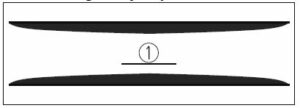
- “BRAKE!” message is displayed
NOTE
During brake control, the collision warning sound is activated intermittently.
Rear crossing
The Rear Crossing detection function is designed to reduce the damage in the event of a collision with a vehicle approaching from the rear sides while driving in reverse.
The Rear Crossing detection function detects approaching vehicles using the rear side radar sensors. If there is the possibility of your vehicle colliding with a vehicle approaching from the rear sides while you are driving in reverse, you are notified of possible danger by a warning sound and a warning indication on the display. Furthermore, if the possibility of a collision increases, brake control is performed to reduce damage in the event of a collision.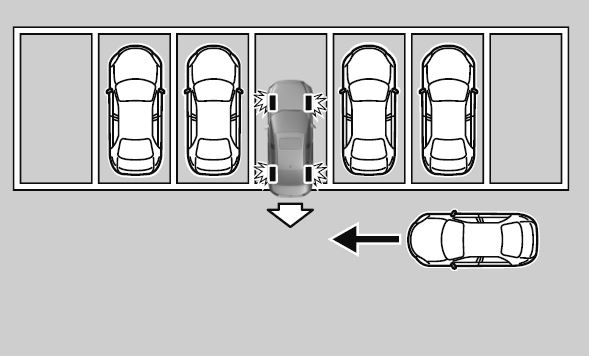
WARNING
Always check the surrounding area visually when reversing the vehicle: The operation of the Rear Crossing detection function has certain limitations. Therefore, the function might not operate or it might be delayed even if there is a vehicle passing through the rear of your vehicle. Always make it your responsibility as a driver to check the rear.
Do not rely completely on the Rear Crossing detection function:
The Rear Crossing detection function operates on vehicles while you are driving in reverse. It will not operate on walls, pedestrians, or animals.
Operation conditions
The Rear Crossing detection function operates when all of the following conditions are met.
- The engine is running.
The SBS is on. - (Automatic transmission)
The selector lever is in the R position. - (Manual transmission)
The shift lever is in the R position. - The vehicle speed is about 10 km/h (6.2 mph) or slower.
- The vehicle speed of an approaching vehicle is about 3 km/h (2 mph) or faster.
- There is no problem with the DSC.
NOTE
- When any of the following conditions is met, the i-ACTIVSENSE warning indication/warning light is turned on and the system operation is stopped. If the i-ACTIVSENSE warning indication/warning light remains on, have the vehicle inspected by an Authorized Mazda Dealer as soon as possible.
- There is a problem with the system.
- A large deviation in the installation position of a rear side radar sensor on the vehicle has occurred.
- Snow, ice, or mud is adhering around a rear side radar sensor.
- The temperature around a rear side radar sensor is high.
- Driving on snow-covered roads for long periods.
- The battery voltage has decreased.
- When any of the following conditions is met, the Rear Crossing detection function will not detect approaching vehicles or they may be difficult to detect.
The rear side radar sensor detection area is obstructed by a nearby wall or parked vehicle. (Reverse the vehicle to a position where the radar sensor detection area is no longer obstructed.)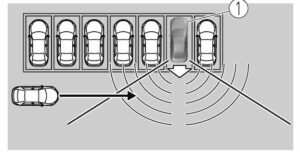
- A vehicle is approaching directly from the rear of your vehicle.
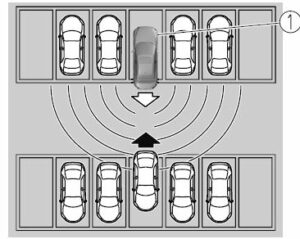 Your vehicle
Your vehicle
- The vehicle is parked on a slant.

- A vehicle is approaching from the opposite direction on a steep gradient.
- Your vehicle
- Directly after the engine starts.
- Just after the SBS operation has been enabled using [Settings] in Mazda Connect.
- Radio wave interference from a radar sensor equipped on a vehicle parked nearby.
- When any of the following conditions is met, the Rear Crossing may operate.
- There is a hanging curtain or railroad crossing gate.
- Reversing near objects such as foliage, barriers, vehicles, walls, or fences.
- The vehicle is driven on rough roads such as in areas where there is grass and foliage or off-road.
- When reversing through low gates, narrow gates, car washing machines, or tunnels.
- A towing bar is installed or a trailer is connected.
- (Manual transmission)
- On a manual transmission vehicle, the engine stops if the clutch pedal is not depressed when the vehicle is stopped by the SBS brake operation.
- If the vehicle is stopped by the SBS brake operation and the brake pedal is not depressed, the SBS brake is automatically released after about 2 seconds.
Collision warning
If there is the possibility of your vehicle colliding with a vehicle approaching from the rear on the left or right, or from the rear while you are driving in reverse, a warning sound is activated continuously and a warning is displayed on the multi-information display and the active driving display. Multi-information display.
- “BRAKE!” message is displayed Active driving display*
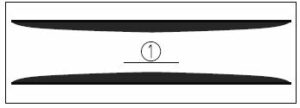
- “BRAKE!” message is displayed
NOTE
During brake control, the collision warning sound is activated intermittently.
Stopping the Smart Brake Support (SBS) System Operation
The SBS can be changed to inoperable.
Refer to the Settings section in the Mazda Connect Owner’s Manual.
When the SBS is canceled, the SBS OFF indicator light turns on.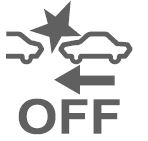
NOTE
When the ignition is switched OFF while the SBS forward drive detection is canceled, the SBS forward drive detection is automatically enabled the next time the ignition is switched ON.
Smart Brake Support [Rear] (SBS-R)
The SBS-R is a system which is designed to reduce damage in the event of a collision by operating the brake control (SBS brake) when the system’s sensors detect an obstruction at the rear of the vehicle while driving at a speed of about 2 to 8 km/h (2 to 4 mph) and the system determines that a collision is unavoidable.
WARNING
Do not rely completely on the SBS-R system:
- The SBS-R system is only designed to reduce damage in the event of a collision. Over reliance on the system leading to the accelerator pedal or brake pedal being mistakenly operated could result in an accident.
To assure the correct operation of the SBS-R, heed the following cautions. - Do not apply a sticker to a rear ultrasonic sensor and rear camera. Otherwise, the rear ultrasonic sensor and rear camera may not be able to detect vehicles or obstructions which could result in an accident.
- Do not disassemble a rear ultrasonic sensor and rear camera.
- If cracks or damage caused by flying gravel or debris is visible around a rear ultrasonic sensor and rear camera, stop using the SBS-R system immediately and have your vehicle inspected by an Authorized Mazda Dealer. If the vehicle continues to be driven with cracks or scratch marks left around an ultrasonic sensor, the system may operate unnecessarily and cause an unexpected accident.
Refer to Stopping the Smart Brake Support [Rear] (SBS-R) System Operation. Consult an Authorized Mazda Dealer for rear bumper removal.
Do not modify the suspension:
If the vehicle height or inclination is changed, the SBS-R system may not operate correctly because it cannot detect obstructions correctly.
Do not apply a strong force to a rear ultrasonic sensor and rear camera:
When washing the vehicle, do not spray highly pressurized water against a rear ultrasonic sensor and rear camera, or rub it strongly. In addition, do not hit the rear bumper forcefully when loading and unloading cargo. Otherwise, the sensors may not detect obstructions correctly which could cause the SBS-R system to not operate normally, or it could operate unnecessarily.
CAUTION
- When driving off-road in areas where there is grass or foliage, it is recommended that the SBS-R system be turned off.
- Always use tires of the specified size and the same manufacturer, brand, and tread pattern on all 4 wheels. In addition, do not use tires with significantly different wear patterns on the same vehicle. Otherwise, the SBS-R system may not operate normally.
- If ice or snow is stuck on the rear ultrasonic sensor and rear camera they may not be able to detect obstructions correctly depending on the conditions. In such cases, the system may not be able to perform controls correctly. Always drive carefully and pay attention to the rear of the vehicle.
- The vehicle posture changes depending on the accelerator pedal, brake pedal and steering wheel operations, which could make it difficult for the system to recognize an obstruction, or it could facilitate unnecessary detection. In such cases, the SBS-R may or may not operate.
- The SBS-R system will operate under the following conditions.
- The engine is running for 3 seconds or more.
- The shift lever (manual transmission vehicle) or the selector lever (automatic transmission vehicle) is in the R (reverse) position.
i-ACTIVSENSE warning indication warning light is not displayed in the multi-information display. - The vehicle speed is between about 2 to 8 km/h (2 to 4 mph).
- The SBS-R is not turned off.
- The DSC is not malfunctioning.
- In the following cases, the rear ultrasonic sensor and rear camera cannot detect obstructions and the SBS-R may not operate.
- The height of the obstruction is low such as low walls or trucks with low loading platforms.
- The height of the obstruction is high such as trucks with high loading platforms.
- The obstruction is small.
- The obstruction is thin such as a signpost.
- The surface of the obstruction is not pointed vertically relative to the vehicle.
- The obstruction is soft such as a hanging curtain or snow stuck to a vehicle.
- The obstruction is shaped irregularly.
- The obstruction is extremely close.
- In the following cases, the rear ultrasonic sensor and rear camera cannot detect obstructions correctly and the SBS-R may not operate.
- Something is stuck on the bumper near a rear ultrasonic sensor.
- The brake or accelerator pedal is operated.
- There is another obstruction near one obstruction.
- During inclement weather such as rain, fog and snow.
- High or low humidity.
- High or low temperatures
- Strong winds.
- The path of travel is not flat.
- Heavy luggage is loaded in the luggage compartment or on the rear seat.
- Objects such as a wireless antenna, fog light, or illuminated license plate is installed near a rear ultrasonic sensor.
- The orientation of a rear ultrasonic sensor has deviated for reasons such as a collision.
The vehicle is affected by other sound waves such as the horn, engine noise, ultrasonic sensor of another vehicle. - In the following cases, a rear ultrasonic sensor and rear camera may detect something as a target obstruction which could cause the SBS-R system to operate.
- There is a steep slope or bump.
- There are wheel blocks or a curbstone.
- There are hanging curtains, gate poles such as at toll gates and railroad crossing.
- When traveling near objects such as foliage, barriers, vehicles, walls, and fences along a road.
- When driving off-road in areas where there is grass and forage.
- When passing through low gates, narrow gates, car washing machines, and tunnels.
- A trailer is connected.
- An exterior accessory such as a bicycle carrier is installed around a rear ultrasonic sensor.
- (Manual transmission)
If the vehicle is stopped by the SBS-R operation and the clutch pedal is not depressed, the engine stops. - When the system operates, the user is notified by the multi-information display.
- The collision warning beep sounds intermittently while the SBS-R brake is operating.
- If the vehicle is stopped by the SBS-R operation and the brake pedal is not depressed, displaying in meter “Emergency Braking Activated. Depress Brake Pedal to Hold Stop”, after about 2 seconds and the SBS-R brake is automatically released.
- Turn off the SBS-R system while pulling a trailer or while an accessory such as a bicycle carrier is installed to the rear of the vehicle.
Collision Warning
If there is a possibility of a collision, the collision warning sound is activated continuously and a warning is displayed on the active driving display and the multi-information display. Multi-information display.
- “BRAKE!” message is displayed
Active driving display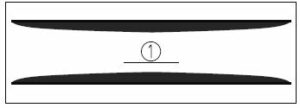
- “BRAKE!” message is displayed.
Stopping the Smart Brake Support [Rear] (SBS-R) System Operation
The SBS-R can be changed to inoperable. Refer to the Settings section in the Mazda Connect Owner’s Manual. When the SBS-R is canceled, the SBS OFF indicator light turns on.
NOTE
When the SBS-R is canceled, the Smart Brake Support [Rear Crossing] (SBS-RC) is also canceled.
Smart Brake Support [Rear Crossing] (SBS-RC)
The SBS-RC is a system designed to assist the driver in avoiding collisions and to reduce damage in the event of a collision by applying the brakes if there is the possibility of collision with a vehicle approaching from the rear while you are reversing out of parking space. The SBS-RC system detects vehicles approaching from the rear left and right sides of the vehicle, and the rear of the vehicle while the vehicle is being reversed out of a parking space, the system reduces damage in the event of a collision by operating the brake control when the system determines that a collision is unavoidable. SBS-RC operation
SBS-RC operation
- The SBS-RC system operates when the shift lever (manual transmission) or the selector lever (automatic transmission) is shifted to the reverse (R) position.
- If there is the possibility of a collision with an approaching vehicle, the SBS-RC system applies brake and displays “BRAKE!” on the active driving display and the multi-information display.
WARNING
Always check the surrounding area visually before actually putting the vehicle in reverse:
The system is only designed to assist you in backing out of the lot when putting the vehicle in reverse. Due to certain limitations with the operation of this system, the SBS-RC system may not operate brake or it might be delayed even though a vehicle is behind your vehicle. Always make it your responsibility as a driver to check the rear.
Do not rely completely on the SBS-RC system:
- The SBS-RC system is only designed to reduce damage in the event of a collision. Over reliance on the system leading to the accelerator pedal or brake pedal being mistakenly operated could result in an accident.
- The SBS-RC system operates in response to a vehicle. The system does not operate in response to obstructions such as a wall, pedestrians, or animals.
To assure the correct operation of the SBS-RC, heed the following cautions
- Do not apply a sticker to a rear radar and rear camera. Otherwise, the rear radar and rear camera may not be able to detect vehicles or obstructions which could result in an accident.
- Do not disassemble a rear radar and rear camera.
- If cracks or damage caused by flying gravel or debris is visible around a rear radar and rear camera, stop using the SBS-RC system immediately and have your vehicle inspected by an Authorized Mazda Dealer. If the vehicle continues to be driven with cracks or scratch marks left around an ultrasonic sensor, the system may operate unnecessarily and cause an unexpected accident. Refer to Stopping the Smart Brake Support [Rear Crossing] (SBS-RC) System Operation.
- Consult an Authorized Mazda Dealer for rear bumper removal.
Do not modify the suspension:
If the vehicle height or inclination is changed, the SBS-RC system may not operate correctly because it cannot detect obstructions correctly.
Do not apply a strong force to a rear radar and rear camera:
When washing the vehicle, do not spray highly pressurized water against a rear radar and rear camera, or rub it strongly. In addition, do not hit the rear bumper forcefully when loading and unloading cargo. Otherwise, the sensors may not detect obstructions correctly which could cause the
SBS-RC system to not operate normally, or it could operate unnecessarily.
NOTE
- The SBS-RC system will operate under the following conditions.
- The engine is running for 3 seconds or more.
- The shift lever (manual transmission vehicle) or the selector lever (automatic transmission vehicle) is in the R (reverse) position.
- i-ACTIVSENSE warning indication/warning light is not displayed in the multi-information display.
- The vehicle speed is under about 10 km/h (6 mph).
- The vehicle speed of an approaching vehicle is about 3 km/h (2 mph) or faster.
- The SBS-R is not turned off.
- The DSC is not malfunctioning.
- In the following cases, the
- i-ACTIVSENSE warning indication/warning light turns on and operation of the system is stopped. If the
- i-ACTIVSENSE warning indication/warning light remains illuminated, have the vehicle inspected at an Authorized Mazda Dealer as soon as possible.
- Some problem with the system including the SBS-RC system.
- A large deviation in the installation position of a rear side radar sensor on the vehicle has occurred.
- There is a large accumulation of snow or ice on the rear bumper near a rear side radar sensor.
- Driving on snow-covered roads for long periods.
- The temperature near the radar sensors becomes extremely hot due to driving for long periods on slopes during the summer.
- The battery voltage has decreased.
- Under the following conditions, the rear side radar sensor cannot detect target objects or it may be difficult to detect them.
- The rear side radar sensor detection area is obstructed by a nearby wall or parked vehicle.
(Reverse the vehicle to a position where the radar sensor detection area is no longer obstructed.)
- Your ve2hicle
- A vehicle is approaching directly from the rear of your vehicle.

- Your vehicle
- The vehicle is parked on a slant.

- Your vehicle
- A vehicle is approaching from the opposite direction on a steep gradient.

- Your vehicle
- Directly after the SBS-RC system becomes operable using the personalization feature.
- Radio wave interference from a radar sensor equipped on a nearby parked vehicle.
- Turn off the SBS-RC system while pulling a trailer or while an accessory such as a bicycle carrier is installed to the rear of the vehicle. Otherwise, the radio waves emitted by the radar will be blocked causing the system to not operate normally.
- In the following cases, a rear radar and rear camera may detect something as a target obstruction which could cause the SBS-RC system to operate.
- There are hanging curtains, gate poles such as at toll gates and railroad crossing.
- When traveling near objects such as foliage, barriers, vehicles, walls, and fences along a road.
- When driving off-road in areas where there is grass and forage.
- When passing through low gates, narrow gates, car washing machines, and tunnels.
- A trailer is connected.
- When a rear-mounted bike rack (towbar bike carrier) is installed.
- (Manual transmission)
If the vehicle is stopped by the
SBS-RC operation and the clutch pedal is not depressed, the engine stops. - When the system operates, the user is notified by the multi-information display.
- The collision warning beep sounds intermittently while the SBS-RC brake is operating.
- If the vehicle is stopped by the SBS-RC operation and the brake pedal is not depressed, displaying in meter “Emergency Braking Activated. Depress Brake Pedal to Hold Stop”, after about 2 seconds and the SBS-RC brake is automatically released.
Collision Warning
If there is a possibility of a collision, the collision warning sound is activated continuously and a warning is displayed on the active driving display and the multi-information display. Multi-information display.
- “BRAKE!” message is displayed
Active driving display
- “BRAKE!” message is displayed
Stopping the Smart Brake Support [Rear Crossing] (SBS-RC) System Operation
The SBS-RC can be changed to inoperable. Refer to the Settings section in the Mazda Connect Owner’s Manual. When the SBS-RC is canceled, the SBS OFF indicator light turns on.
NOTE
When the SBS-RC is canceled, the Smart Brake Support [Rear] (SBS-R) is also canceled.
360° View Monitor
The 360° View Monitor consists of the following functions which assist the driver in checking the area surrounding the vehicle using various indications in the center display and a warning sound while the vehicle is being driven at low speeds or while parking.
- Top view
The top view displays an image of the vehicle from directly above on the center display by combining the images taken from the 4 cameras set on all sides of the vehicle. The top view displays on the right side of the screen when the front view or rear view screen is being displayed. The top view assists the driver in checking the area surrounding the vehicle when the vehicle is moving forward or in reverse. - Front view/front wide view
The image from the front of the vehicle is displayed on the center display.
The view from the front assists the driver in checking the front of the vehicle by displaying guide lines on the displayed image taken from the front of the vehicle. - Side view
The images taken from the front left and right sides of the vehicle are displayed on the center display. The side view assists the driver in checking the front sides of the vehicle by displaying guide lines on the displayed image taken from the front left and right sides of the vehicle. - Rear view/rear wide view
The image from the rear of the vehicle is displayed on the center display.
The image from the rear assists the driver in checking the rear of the vehicle by displaying guide lines on the displayed image taken from the rear of the vehicle. - Parking sensor
If there are any obstructions near the vehicle while the top view/side view is displayed, an obstruction detection indication turns on around the bumper in the center display. The parking sensors use ultrasonic sensors to detect obstructions around the vehicle when the vehicle is driven at low speeds, such as during garage or parallel parking, and notifies the driver of the approximate distance from the vehicle to the surrounding obstruction using sound and an obstruction detection indication. Refer to Parking Sensor System . - Front Cross Traffic Alert (FCTA)
If there is the possibility of a collision with an approaching vehicle while the front view/front wide view/side view is displayed, a warning is displayed on the center display. The Front Cross Traffic Alert (FCTA) is designed to assist the driver in checking both sides of the vehicle when the vehicle starts to drive at an intersection. - Refer to Front Cross Traffic Alert
- (FCTA) on
- Rear Cross Traffic Alert (RCTA)
If there is the possibility of a collision with an approaching vehicle while the rear view/rear wide view is displayed, a warning is displayed on the center display. The Rear Cross Traffic Alert (RCTA) uses rear side radar sensor to detect vehicles approaching from the rear left and right sides of the vehicle, and it assists the driver in checking the rear of the vehicle while reversing by flashing the Blind Spot Monitoring (BSM) warning lights and activating the warning sound. Refer to Rear Cross Traffic Alert (RCTA) on page 4-126.
360° View Monitor Range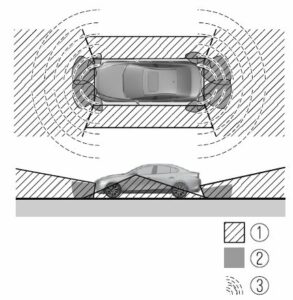
- Cameras
- Ultrasonic sensors
- Front/Rear side radar sensors
WARNING
Always confirm the safety of the area around the vehicle with the mirrors and directly with your eyes when driving: The 360° View Monitor is an auxiliary device which assists the driver in checking the safety of the area around the vehicle. The shooting range of the cameras and detection range of the sensors are limited. For example, the areas in black at the front and rear of the vehicle image and the seams where each of the camera images merge are blind spots where an obstruction may not be visible. In addition, the extended vehicle width lines and projected vehicle path lines are only to be used as references, and the images on the screen may differ from the actual conditions.
CAUTION
- Do not use the 360° View Monitor under any of the following conditions.
- Icy or snow-covered roads.
Tire chains or a temporary spare tire is installed. - The front or rear doors are not fully closed.
- The vehicle is on a road incline.
- Bumpy roads.
- The door mirrors are retracted.
- Do not hit the front/rear camera, front/rear bumper, and door mirrors forcefully. The camera position or installation angle may shift.
- The cameras are waterproof. Do not disassemble, modify, or remove a camera.
- The camera cover is made of hard plastic, therefore do not apply oil film remover, organic solvents, wax, or coating agents. If any such agent gets on the camera cover, wipe it off using a soft cloth immediately.
- Do not rub the camera lens forcefully, or clean it with an abrasive or hard brush. Otherwise, it could scratch the camera lens and negatively affect the images.
- If a camera lens is severely damaged by flying gravel, have the camera replaced. For camera replacement, consult an Authorized Mazda Dealer. Consult an Authorized Mazda Dealer for repair, painting, or replacement of the front/rear camera, front/rear bumper and door mirrors.
- Heed the following cautions to assure that the 360° View Monitor operates normally.
- Do not modify the vehicle suspensions or lower/raise the vehicle body, or both.
- Always use tires of the specified type and size for the front and rear wheels. Consult an Authorized Mazda Dealer for tire replacement.
- When the display is cold, images may leave trails or the screen might be darker than usual, making it difficult to check the vehicle surroundings. Always confirm the safety at the front and around the vehicle visually when driving.
- The method for parking/stopping the vehicle using the 360° View Monitor differs depending on the road circumstances/conditions and the vehicle conditions. When and how much you turn the steering wheel will differ depending on the situation, therefore always check the vehicle surroundings directly with your eyes while using the system. Also, before using the system, always make sure that the vehicle can be parked/stopped in the parking/stopping space.
NOTE
- If there are water droplets, snow, or mud on the camera lens, wipe it off using a soft cloth. If the camera lens is especially dirty, wash it off with mild detergent.
- If the camera lens is touched or there is any dirt on it, it could affect the screen image. Wipe the lens using a soft cloth.
- If the area where the camera is installed, such as the front/rear bumper or door mirrors, has been damaged in a vehicle accident, the camera (position, installation angle) may have shifted. Always consult an Authorized Mazda Dealer to have the vehicle inspected.
- If the camera is subjected to excessive changes in temperature such as by pouring hot water on the camera during cold weather, the 360° View Monitor may not operate normally.
- If the vehicle is driven during cold temperatures and the camera temperature decreases, the top view and the side view may become unclear. However, this does not indicate a problem. If the vehicle is stopped for a while and the camera temperature increases, the top view and the side view will return to the normal condition.
- If the battery voltage is low, the screen might be temporarily difficult to view, however, this does not indicate a problem.
- The 360° View Monitor has limitations. Objects under the bumper or near both ends of the bumper cannot be displayed.
- Obstructions above the upper image range of the camera are not displayed.
- Under the following conditions, the screen might be difficult to view, however this does not indicate a problem.
- The temperature near the lens is high/low.
- Rainy conditions, water droplets on the camera, or high humidity.
- Mud or foreign matter near the camera.
- The area around the vehicle is dark.
- Extremely bright light such as sunlight or headlights hitting the camera lens directly.
- The surroundings are illuminated by vehicle lights, fluorescent lights, or LED lights (display may flicker).
- Extremely small dark or white dots appear on the screen (dots may flicker).
- An object is close to a camera.
- Because the 360° View Monitor camera uses a special lens, the distance displayed on the screen differs from the actual distance.
- Obstructions displayed on the screen may appear differently than in actuality. (Obstructions may appear fallen, larger, or longer than they actually are.)
- Do not apply stickers to a camera or the area around it. In addition, do not install accessories or an illuminated number/character license plate to the area around a camera. Otherwise, the camera may not correctly display the surrounding conditions.
- Only rear and rear wide images displayed on the monitor from the 360° View Monitor camera are reversed images (mirror images).
- Free/open source software information
This product includes free/open sources. Information about the licensing and source code is available at the following URL.
https://www.denso.com/
Types of Images Displayed on the Screen
Top view/Front view
Displays the image of the area around the vehicle and the vehicle front.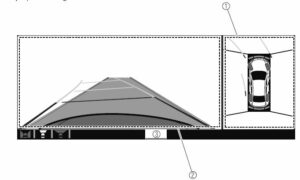
- Top view screen
- Front view screen
- “Check surroundings for safety.” message is displayed
Top view/Front wide view
Displays the image of the area around the vehicle and the front of the vehicle (wide-area).
- Top view screen
- Front wide view screen
- “Check surroundings for safety.” message is displayed
Side view
Displays the image of the left and right sides of the vehicle.
- Left side view screen
- Right side view screen
- “Check surroundings for safety.” message is displayed.
Top view/Rear view
Displays the image of the area around the vehicle and the rear of the vehicle.
- Top view screen
- Rear view screen
- “Check surroundings for safety.” message is displayed.
Top view/Rear wide view
Displays the image of the area around the vehicle and the rear of the vehicle (wide-area).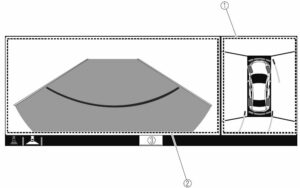
- Top view screen
- Rear wide view screen
- “Check surroundings for safety.” message is displayed.
How to Use the System
Top view/Front view, Top view/Front wide view, Side view.
Indication
Images are displayed on the screen when the 360° View Monitor switch is pressed with all of the following conditions met.
- The ignition is switched ON.
- The shift lever/selector lever is in a position other than R.

Display switching
The displayed screen can be changed each time the 360° View Monitor switch is pressed.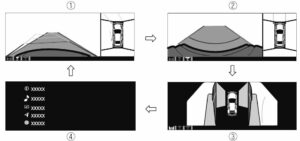
- Top view/Front view
- Top view/Front wide view
- Side view
- Home screen
NOTE
- When the shift lever/selector lever is in R position, the displayed screen does not switch to the top view/front view, top view/front wide view, or the side view.
- Display of the top view/front view, top view/front wide view, or the side view stops even with the display conditions met if any of the following conditions occurs.
- When a switch around the commander knob is pressed.
- (Manual transmission)
The parking brake is applied. - (Automatic transmission)
The selector lever is shifted to P position (displayed when the selector lever is in a position other than P). - (Displayed when vehicle speed is less than 15 km/h (9.3 mph))
- 4 minutes and 30 seconds have passed.
- The vehicle speed is about 15 km/h (9.3 mph) or faster.
- (Displayed when the vehicle speed is about 15 km/h (9.3 mph) or faster)
- The vehicle speed is about 15 km/h (9.3 mph) or faster after 8 seconds have passed since pressing the 360° View Monitor switch.
- 4 minutes and 22 seconds have passed from the point when the vehicle speed was less than 15 km/h (9.3 mph) after 8 seconds have passed since pressing the 360° View Monitor switch.
- The 360° View Monitor settings can be changed as follows.
Refer to the Settings section in the Mazda Connect Owner’s Manual. - Automatic display of the 360° View Monitor when the ultrasonic sensor detects an obstruction.
- Automatic display of the 360° View Monitor when the ignition is switched ON.
- Screen priority level when the system launches.
Top view/Rear view, Top view/Rear wide view
The top view/rear view, top view/rear wide view displays when all of the following conditions are met.
- The ignition is switched ON.
- Shift lever/selector lever is in R position.
Display switching
The displayed screen can be changed each time the 360° View Monitor switch is pressed.
- Top view/Rear view
- Top view/Rear wide view
NOTE
- The top view/rear view and top view/rear wide view automatically display whether or not the 360° View Monitor switch is turned on or off when shifting the shift lever/selector lever to R position.
- The top view/rear view and top view/rear wide view displays the previously displayed screen.
- The setting can be changed to display the top view/front view when shifting from reverse to a forward gear without operating the 360° View Monitor switch to check the front of the vehicle while parallel parking.
- Refer to the Settings section in the Mazda Connect Owner’s Manual.
WARNING
Always stop the vehicle when adjusting the 360° View Monitor image quality. Do not adjust the 360° View Monitor image quality while driving. If you adjust the 360° View Monitor image quality (such as brightness, contrast, tone, and color density) while driving, it could lead to an unexpected accident.
|
|
Display/Icon |
Content |
| (1) | View status icon |
Indicates which image is displayed among the front view/front wide view/side view/rear view/rear wide view. |
| (2) | Parking sensor status icon |
Indicates that the parking sensor has a problem or it is switched off. |
Top View/Front View
Use the top view/front view to assist in checking the safety of the surrounding area when accelerating from a stop, parking, or stopping the vehicle.
Display range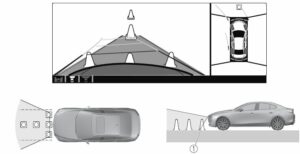
- Target object
NOTE
- In the top view screen, the areas in black at the front and rear of the vehicle image and the seams where each of the camera images merge are blind spots.
- Because images displayed in the top view screen are processed from each camera, the top view screen may display in the following ways.
- Depending on the surrounding environment, the color of objects may be displayed on the screen in a color different from the actual one.
- Depending on the surrounding environment, it may take a few seconds for the color of the screen display to adjust.
- Obstructions displayed in the front view may not display on the top view screen.
- If the position or angle of each camera changes due to tilting of the vehicle, the image may appear distorted.
- Lines on the road may appear distorted at the seams where each of the camera images merge.
- The screen area for each camera may appear bright/dark depending on the illumination level around any of the cameras.
Viewing the screen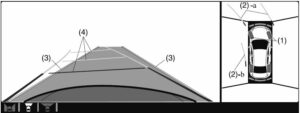
| Display/Icon | Content | |
| (1) | Tire icon | Indicates the tire direction. Moves in conjunction with the steering wheel operation. |
| (2) | Projected vehicle path lines (yellow & red) | Indicates the approximate projected path of the vehicle. Moves in conjunction with the steering wheel operation.
|
| (3) | Extended vehicle width lines (blue) |
|
| (4) | Projected vehicle path distance guide lines (yellow & red) | Indicates the distance (from front end of bumper) in front of the vehicle.
|
CAUTION
The parking sensor detection range has limitations. For example, obstructions closing in from the side and objects short in height may not be detected. Always confirm the safety around the vehicle visually when driving. For details, refer to the parking sensor obstruction detection indication and warning sound. Refer to Parking Sensor System on page 4-247.
NOTE
The setting can be changed so that the projected vehicle path lines are not displayed.
Refer to the Settings section in the Mazda Connect Owner’s Manual.
How to use the projected vehicle path line function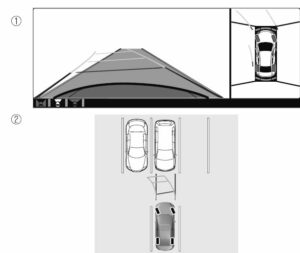
- (Screen display)
- (Actual condition)
Make sure that there are no obstructions within the projected vehicle path lines. Drive the vehicle forward while turning the steering wheel so that no obstructions come within the projected vehicle path lines.
Top View/Front Wide View
Use the top view/front wide view to assist in checking the safety of the surrounding area when accelerating from a stop or entering a T-shaped intersection and intersection.
Display range
- Target object
NOTE
- In the top view screen, the areas in black at the front and rear of the vehicle image and the seams where each of the camera images merge are blind spots.
- Because images displayed in the top view screen are processed from each camera, the top view screen may display in the following ways.
- Depending on the surrounding environment, the color of objects may be displayed on the screen in a color different from the actual one.
- Depending on the surrounding environment, it may take a few seconds for the color of the screen display to adjust.
- Obstructions displayed in the front view may not display on the top view screen.
- If the position or angle of each camera changes due to tilting of the vehicle, the image may appear distorted.
- Lines on the road may appear distorted at the seams where each of the camera images merge.
- The screen area for each camera may appear bright/dark depending on the illumination level around any of the cameras.
Viewing the screen
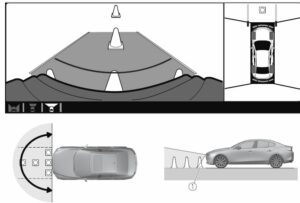
| Display/Icon | Content | |
| (1) | Extended vehicle width lines and distance guide lines (blue & red) | Indicates the approximate width of the vehicle and the distance (from front end of bumper) in front of the vehicle.
|
NOTE
The front wide view screen displays the image in front of the vehicle at a wide angle and corrects the image to help detect approaching obstructions from the side. Therefore, it differs from the actual view.
Side View
Use the side view to assist in checking the safety of the surrounding area when accelerating from a stop, parking, or stopping the vehicle.
Display range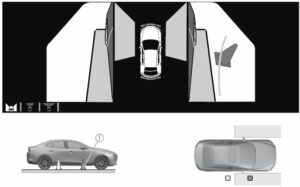
- Target object
Viewing the screen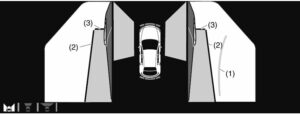
| Display/Icon | Content | |
| (1) | Projected vehicle path lines (yellow) | Indicates the approximate projected path of the vehicle. Moves in conjunction with the steering wheel operation. The projected vehicle path lines (yellow) indicate the path the inner side of the vehicle is expected to travel. |
| (2) | Vehicle parallel guide lines (blue) | Indicates the approximate vehicle width including the door mirrors. |
| (3) | Vehicle front end guide lines (blue) | Indicates the point about 0.25 m (9.84 in) from the front edge of the vehicle (front edge of the bumper). |
NOTE
The setting can be changed so that the projected vehicle path lines are not displayed.
Refer to the Settings section in the Mazda Connect Owner’s Manual.
How to use the projected vehicle path line function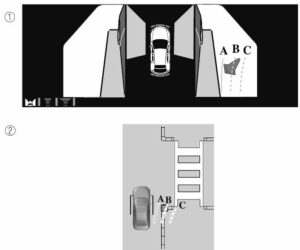
- (Screen display)
- (Actual condition)
Make sure that there are no obstructions within the projected vehicle path lines. Turn the steering wheel so that the projected vehicle path lines travel inside of the obstruction (A), and drive the vehicle forward until it passes the obstruction. If the projected vehicle path lines are on an obstruction (B) or outside of the obstruction (C), the vehicle may contact the obstruction when turning the vehicle sharply.
CAUTION
- The parking sensor detection range has limitations. For example, obstructions closing in from the side and objects short in height may not be detected. Always confirm the safety around the vehicle visually when driving. For details, refer to the parking sensor obstruction detection indication and warning sound. Refer to Parking Sensor System.
- Do not turn the steering wheel any more until the vehicle has passed the obstruction, even if the obstruction is not visible on the side view image. If the steering wheel is turned even more, the vehicle may contact the obstruction if it is turned sharply.
NOTE
- Because there might be a difference between the image displayed on the screen and the actual conditions, always check the safety of the surrounding area using the mirrors and directly with your eyes when driving.
- Even though the object displayed on the screen, such as a road curb or a division line of a parking space, and the vehicle parallel guide lines appear parallel, they may not actually be parallel.
Top View/Rear View
Use the top view/rear view to assist in checking the safety of the surrounding area when accelerating from a stop, parking, or stopping the vehicle.
Range of displayed screen image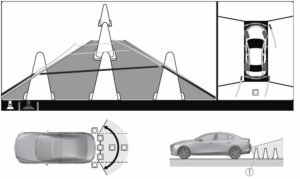
- Target object
NOTE
- In the top view screen, the areas in black at the front and rear of the vehicle image and the seams where each of the camera images merge are blind spots.
- Because images displayed in the top view screen are processed from each camera, the top view screen may display in the following ways.
- Depending on the surrounding environment, the color of objects may be displayed on the screen in a color different from the actual one.
- Depending on the surrounding environment, it may take a few seconds for the color of the screen display to adjust.
- Obstructions displayed in the rear view may not display on the top view screen.
- If the position or angle of each camera changes due to tilting of the vehicle, the image may appear distorted.
- Lines on the road may appear distorted at the seams where each of the camera images merge.
- The screen area for each camera may appear bright/dark depending on the illumination level around any of the cameras.
Viewing the screen
| Display/Icon | Content | |
| (1) | Tire icon | Indicates the tire direction. Moves in conjunction with the steering wheel operation. |
| (2) | Projected vehicle path lines (yellow & red) | Indicates the approximate projected path of the vehicle. Moves in conjunction with the steering wheel operation.
|
| (3) | Extended vehicle width lines (blue) | These guide lines indicate the approximate width of the vehicle. |
| (4) | Projected vehicle path distance guide lines (yellow & red) | These guide lines indicate the approximate distance to a point measured from the rear of the vehicle (from the end of the bumper).
|
NOTE
The setting can be changed so that the projected vehicle path lines are not displayed.
Refer to the Settings section in the Mazda Connect Owner’s Manual.
How to use the projected vehicle path line function
CAUTION
- The front of the vehicle swings out wide when turning the steering wheel while reversing. Maintain sufficient distance between the vehicle and an obstruction.
The parking sensor detection range has limitations. For example, obstructions closing in from the side and objects short in height may not be detected. Always confirm the safety around the vehicle visually when driving. - For details, refer to the parking sensor obstruction detection indication and warning sound.
NOTE
- Because there might be a difference between the image displayed on the screen, such as indicated in the following, and the actual conditions when parking, always check the safety at the rear of the vehicle and the surrounding area directly with your eyes.
- Even though the back end of the parking space (or garage) displayed on the screen and distance guide lines appear parallel, they may not actually be parallel.
- When parking in a space with a division line on only one side of the parking space, even though the division line and the vehicle width guide line appear parallel, they may not actually be parallel.
- The following shows an example of vehicle parking with the steering wheel turned to the left while backing up the vehicle. When backing into a parking space from the opposite direction, the steering operation is reversed.
- Back the vehicle into the parking space by turning the steering wheel so that the vehicle enters the center of the parking space.
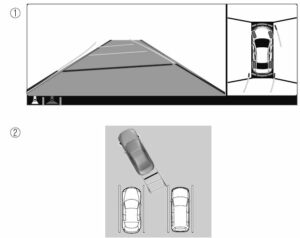
- (Screen display)
- (Actual condition)
- After the vehicle starts entering the parking space, stop and adjust the steering wheel so that the distance between the vehicle width lines and the sides of the parking space on the left and right are roughly equal, and then continue backing up slowly.
- Once the vehicle width lines and the sides of the parking space on the left and right are parallel, straighten the wheels and back the vehicle slowly into the parking space. Continue checking the vehicle’s surroundings and then stop the vehicle in the best possible position. (If the parking space has division lines, check whether the vehicle width guide lines are parallel to them.)
 (Screen display)
(Screen display)
- (Actual condition)
Top View/Rear Wide View
Use the top view/rear wide view to assist in checking the safety of the surrounding area when accelerating from a stop, parking, or stopping the vehicle.
Range of displayed screen image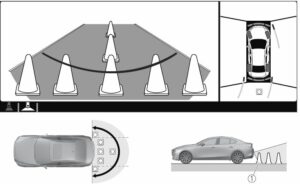
- Target object
NOTE
- In the top view screen, the areas in black at the front and rear of the vehicle image and the seams where each of the camera images merge are blind spots.
- Because images displayed in the top view screen are processed from each camera, the top view screen may display in the following ways.
- Depending on the surrounding environment, the color of objects may be displayed on the screen in a color different from the actual one.
- Depending on the surrounding environment, it may take a few seconds for the color of the screen display to adjust.
- Obstructions displayed in the front view may not display on the top view screen.
- If the position or angle of each camera changes due to tilting of the vehicle, the image may appear distorted.
- Lines on the road may appear distorted at the seams where each of the camera images merge.
- The screen area for each camera may appear bright/dark depending on the illumination level around any of the cameras.
Viewing the screen
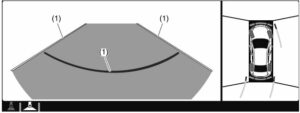
| Display/Icon | Content | |
| (1) | Extended vehicle width lines and distance guide lines (blue & red) | These guide lines indicate the approximate width of the vehicle and distance to a point measured from the rear of the vehicle (from the end of the bumper).
|
NOTE
The top view/rear wide view screen displays the image at the rear of the vehicle at a wide angle and corrects the image to help detect approaching obstructions from the side. Therefore, it differs from the actual view.
Margin of Error Between Road Surface on Screen and Actual Road Surface
There might be some margin of error between the road surface appearing on the screen and the actual road surface. A margin of error in the perceived distance could lead to an accident, therefore be aware of the following conditions which can more easily produce errors in the perceived distance. The vehicle tilts due to weight of passengers and cargo. If the vehicle is tilted, obstructions picked up by a camera can appear farther or closer than the actual distance from the vehicle.
Front camera

- Obstruction
- Margin of error
Side camera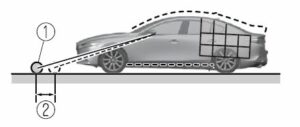
- Obstruction
- Margin of error
Rear camera There is a steep up or down grade in the road at the front or rear of the vehicle
There is a steep up or down grade in the road at the front or rear of the vehicle
If there is a steep up or down grade in the road at the front or rear of the vehicle, obstructions picked up by the camera can appear farther or closer than the actual distance from the vehicle.
Front camera
- Appears further than actual distance
- Distance of obstruction being viewed on screen
- Actual distance of obstruction from vehicle
- Actual obstruction
- Obstruction appearing on screen
- Appears closer than actual distance
Side camera
- Appears further than actual distance
- Distance of obstruction being viewed on screen
- Actual distance of obstruction from vehicle
- Actual obstruction
- Obstruction appearing on screen
- Appears closer than actual distance
Rear camera
- Appears further than actual distance
- Distance of obstruction being viewed on screen
- Actual distance of obstruction from vehicle
- Obstruction appearing on screen
- Actual obstruction
- Appears closer than actual distance
NOTE
If the vehicle is on a slope, obstructions taken by the camera can appear farther or closer than the actual distance from the vehicle.
Three-dimensional object at vehicle front or rear
Because the vehicle front end guide lines (side camera) or the distance guide lines (rear camera) are displayed based on a flat surface, the distance to the three-dimensional object displayed on the screen is different from the actual distance.
Side camera
- (Screen display)
- (Actual condition)
Rear camera
- (Screen display)
- (Actual condition)
- Sensed distance on screen A>B>C
- Actual distance B>C=A
System Problem Indication
| Center display indication | Cause | Action to be taken |
| “No camera signal.” is displayed | The control unit might be damaged. | Have your vehicle inspected by an Authorized Mazda Dealer. |
| Screen is pitch-black and blank | The camera might be damaged. |
Forward Sensing Camera (FSC)
Forward Sensing Camera (FSC)
Your vehicle is equipped with a Forward Sensing Camera (FSC). The Forward Sensing Camera (FSC) is positioned near the rearview mirror and used by the following systems.
- High Beam Control System (HBC) Lane Departure Warning System (LDWS) Traffic Sign Recognition System (TSR) Distance & Speed Alert (DSA) Driver Attention Alert (DAA) Mazda Radar Cruise Control (MRCC) Mazda Radar Cruise Control with Stop & Go function (MRCC with Stop & Go function) Lane-keep Assist System (LAS) Traffic Jam Assist (TJA) Smart Brake Support (SBS) forward drive detection
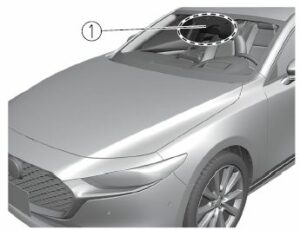 Forward Sensing Camera (FSC)
Forward Sensing Camera (FSC)
The Forward Sensing Camera (FSC) determines the conditions ahead of the vehicle while traveling at night and detects traffic lanes. The distance in which the Forward Sensing Camera (FSC) can detect objects varies depending on the surrounding conditions.
WARNING
Do not modify the suspension:
If the vehicle height or inclination is changed, the system will not be able to correctly detect vehicles ahead. This will result in the system not operating normally or mistakenly operating, which could cause a serious accident.
CAUTION
- Do not apply accessories, stickers or film to the windshield near the Forward Sensing Camera (FSC). If the area in front of the Forward Sensing Camera (FSC) lens is obstructed, it will cause the system to not operate correctly. Consequently, each system may not operate normally which could lead to an unexpected accident. Do not disassemble or modify the Forward Sensing Camera (FSC). Disassembly or modification of the Forward Sensing Camera (FSC) will cause a malfunction or mistaken operation. Consequently, each system may not operate normally which could lead to an unexpected accident. Heed the following cautions to assure the correct operation of the Forward Sensing Camera (FSC). Be careful not to scratch the Forward Sensing Camera (FSC) lens or allow it to get dirty.
- Do not remove the Forward Sensing Camera (FSC) cover. Do not place objects on the dashboard which reflect light. Always keep the windshield glass around the camera clean by removing dirt or fogging. Use the windshield defroster to remove fogging on the windshield. Consult an Authorized Mazda Dealer regarding cleaning the interior side of the windshield around the Forward Sensing Camera (FSC). Consult an Authorized Mazda Dealer before performing repairs around the Forward Sensing Camera (FSC). The Forward Sensing Camera (FSC) is installed to the windshield. Consult an Authorized Mazda Dealer for windshield repair and replacement. When cleaning the windshield, do not allow glass cleaners or similar cleaning fluids to get on the Forward Sensing Camera (FSC) lens. In addition, do not touch the Forward Sensing Camera (FSC) lens. When performing repairs around the rearview mirror, consult an Authorized Mazda Dealer. Consult an Authorized Mazda Dealer regarding cleaning of the camera lens. Do not hit or apply strong force to the Forward Sensing Camera (FSC) or the area around it. If the Forward Sensing Camera (FSC) is severely hit or if there are cracks or damage caused by flying gravel or debris in the area around it, stop using the following systems and consult an Authorized Mazda Dealer.
- High Beam Control System (HBC) Lane Departure Warning System (LDWS) Traffic Sign Recognition System (TSR) Distance & Speed Alert (DSA) Driver Attention Alert (DAA) Mazda Radar Cruise Control (MRCC) Mazda Radar Cruise Control with Stop & Go function (MRCC with Stop & Go function) Lane-keep Assist System (LAS) Traffic Jam Assist (TJA) Smart Brake Support (SBS) forward drive detection
- The direction in which the Forward Sensing Camera (FSC) is pointed has been finely adjusted. Do not change the installation position of the Forward Sensing Camera (FSC) or remove it. Otherwise, it could result in damage or malfunction.
- Always use tires for all wheels that are of the specified size, and the same manufacturer, brand, and tread pattern. In addition, do not use tires with significantly different wear patterns on the same vehicle as the system may not operate normally. The Forward Sensing Camera (FSC) includes a function for detecting a soiled windshield and informing the driver, however, depending on the conditions, it may not detect plastic shopping bags, ice or snow on the windshield. In such cases, the system cannot accurately determine a vehicle ahead and may not be able to operate normally. Always drive carefully and pay attention to the road ahead.
NOTE
- In the following cases, the Forward Sensing Camera (FSC) cannot detect target objects correctly, and each system may be unable to operate normally. The height of the vehicle ahead is low. You drive your vehicle at the same speed as the vehicle ahead. Headlights are not turned on during the night or when going through a tunnel. In the following cases, the Forward Sensing Camera (FSC) may not be able to detect target objects correctly. Under bad weather condition, such as rain, fog and snow.
- The window washer is being used or the windshield wipers are not used when it’s raining.
- Ice, fog, snow, frost, rainfall, dirt, or foreign matter such as a plastic bag is stuck on the windshield. Trucks with low loading platforms and vehicles with an extremely low or high profile.
- When driving next to walls with no patterning (including fences and longitudinally striped walls). The taillights of the vehicle ahead are turned off.
- A vehicle is outside the illumination range of the headlights. The vehicle is making a sharp turn, or ascending or descending a steep slope. Entering or exiting a tunnel. Heavy luggage is loaded causing the vehicle to tilt.
- Strong light is shone at the front of the vehicle (back light or high-beam light from on-coming vehicles). There are many light emitters on the vehicle ahead. When the vehicle ahead is not equipped with taillights or the taillights are turned off at nighttime. Elongated luggage or cargo is loaded onto installed roof rails and covers the Forward Sensing Camera (FSC). Exhaust gas from the vehicle in front, sand, snow, and water vapor rising from manholes and grating, and water splashed into the air.
- When towing a malfunctioning vehicle.
- The vehicle is driven with tires having significantly different wear.
- The vehicle is driven on down slopes or bumpy roads. There are water puddles on the road.
- The surroundings are dark such as during the night, early evening, or early morning, or in a tunnel or indoor parking lot.
- The illumination brightness of the headlights is reduced or the headlight illumination is weakened due to dirt or a deviated optical axis. The target object enters the blind spot of the Forward Sensing Camera (FSC). A person or object bursts onto the road from the shoulder or cuts right in front of you.
- You change lanes and approach a vehicle ahead.
- When driving extremely close to the target object.
- Tire chains or a temporary spare tire is installed. The vehicle ahead has a special shape. For example, a vehicle towing a trailer house or a boat, or a vehicle carrier carrying a vehicle with its front pointed rearward.
- If the Forward Sensing Camera (FSC) cannot operate normally due to rain, backlight, or fog, the system functions related to the Forward Sensing Camera (FSC) are temporarily stopped and the following warning lights turn on. However, this does not indicate a malfunction. High Beam Control System (HBC) warning indication/warning light (amber) i-ACTIVSENSE warning indication/warning light If the Forward Sensing Camera (FSC) cannot operate normally due to high temperatures, the system functions related to the Forward Sensing Camera (FSC) are temporarily stopped and the following warning lights turn on. However, this does not indicate a malfunction. Cool down the area around the Forward Sensing Camera (FSC) such as by turning on the air conditioner. High Beam Control System (HBC) warning indication/warning light (amber) i-ACTIVSENSE warning indication/warning light
- If the Forward Sensing Camera (FSC) detects that the windshield is dirty or foggy, the system functions related to the Forward Sensing Camera (FSC) are temporarily stopped and the following warning lights turn on. However, this does not indicate a problem. Remove the dirt from the windshield or press the defroster switch and defog the windshield. High Beam Control System (HBC) warning indication/warning light (amber) i-ACTIVSENSE warning indication/warning light If there are recognizable cracks or damage caused by flying gravel or debris on the windshield, always have the windshield replaced. Consult an Authorized Mazda Dealer for replacement.
- The Forward Sensing Camera (FSC) recognizes pedestrians when all of the following conditions are met:
The height of a pedestrian is about 1 to 2 meters. An outline such as the head, both shoulders, or the legs can be determined. In the following cases, the Forward Sensing Camera (FSC) may not be able to detect target objects correctly: Multiple pedestrians are walking, or there are groups of people. A pedestrian is close to a separate object. A pedestrian is crouching, lying, or slouching. A pedestrian suddenly jumps into the road right in front of the vehicle. A pedestrian opens an umbrella, or is carrying large baggage or articles. - A pedestrian is in a dark location such as during the night, or blends into the background by wearing clothes matching the background color.
Front Side Radar Sensor
Front Side Radar Sensor
Your vehicle is equipped with front side radar sensor. The following systems also use the front side radar sensor.
- Front Cross Traffic Alert (FCTA)
The front side radar sensor function by detecting the radio waves reflected off a vehicle approaching from the front or an obstruction sent from the radar sensor.

- Front side radar sensor
The front side radar sensors are installed inside the front bumper, one on each side. Always keep the surface of the front bumper near the front side radar sensors clean so that they operate normally. Also, do not apply items such as stickers. Refer to Exterior Care
CAUTION
If the front bumper receives a severe impact, the system may no longer operate normally. Stop the system immediately and have the vehicle inspected at an Authorized Mazda Dealer.
NOTE
- The detection ability of the front side radar sensor has limitations. In the following cases, the detection ability may lower and the system may not operate normally. The front bumper near the front side radar sensor has become deformed. Snow, ice or mud adheres to the front side radar sensor on the front bumper. Under bad weather conditions such as rain, snow and fog. Under the following conditions, the front side radar sensor cannot detect target objects or it may be difficult to detect them. Small motorcycles, bicycles, pedestrians, animals, shopping carts, and stationary objects on a road or a road side. Vehicle shapes which do not reflect radar waves well such as empty trailers with a low vehicle height and sports cars.
- Vehicles are shipped with the direction of the front side radar sensor adjusted for each vehicle to a loaded vehicle condition so that the front side radar sensor detect approaching vehicles correctly. If the direction of the front side radar sensor has deviated for some reason, have the vehicle inspected at an Authorized Mazda Dealer. For repairs or replacement of the front side radar sensor, or bumper repairs, paintwork, and replacement near the radar sensors, consult an Authorized Mazda Dealer.
- The radar sensors are regulated by the relevant radio wave laws of the country in which the vehicle is driven. If the vehicle is driven abroad, authorization from the country in which the vehicle is driven may be required.
Rear Side Radar Sensor
Rear Side Radar Sensor Your vehicle is equipped with rear side radar sensor. The following systems also use the rear side radar sensor.
- Blind Spot Monitoring (BSM) Rear Cross Traffic Alert (RCTA) Smart Brake Support (SBS) reverse drive detection
The rear side radar sensors emit radio waves and detect the radio waves reflected off a vehicle approaching from the rear or an obstruction.
4–Door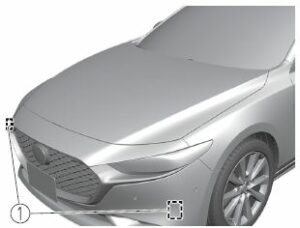 Rear side radar sensor
Rear side radar sensor
5–Door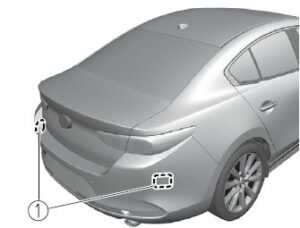 Rear side radar sensor
Rear side radar sensor
The rear side radar sensors are installed inside the rear bumper, one on each side. Always keep the surface of the rear bumper near the rear side radar sensors clean so that they operate normally. Also, do not apply items such as stickers.
CAUTION
If the rear bumper receives a severe impact, the system may no longer operate normally. Stop the system immediately and have the vehicle inspected at an Authorized Mazda Dealer.
NOTE
- The detection ability of the rear side radar sensor has limitations. In the following cases, the detection ability may lower and the system may not operate normally. The rear bumper near the rear side radar sensor has become deformed. Snow, ice or mud adheres to the rear side radar sensor on the rear bumper. Under bad weather conditions such as rain, snow and fog. Under the following conditions, the rear side radar sensor cannot detect target objects or it may be difficult to detect them. Small motorcycles, bicycles, pedestrians, animals, shopping carts, and stationary objects on a road or a road side. Vehicle shapes which do not reflect radar waves well such as empty trailers with a low vehicle height and sports cars.
- Vehicles are shipped with the direction of the rear side radar sensor adjusted for each vehicle to a loaded vehicle condition so that the rear side radar sensor detect approaching vehicles correctly. If the direction of the rear side radar sensor has deviated for some reason, have the vehicle inspected at an Authorized Mazda Dealer.
- For repairs or replacement of the rear side radar sensor, or bumper repairs, paintwork, and replacement near the radar sensors, consult an Authorized Mazda Dealer. The radar sensors are regulated by the relevant radio wave laws of the country in which the vehicle is driven. If the vehicle is driven abroad, authorization from the country in which the vehicle is driven may be required.
Rear/Rear Corner Ultrasonic Sensor*
Rear/Rear Corner Ultrasonic Sensor
The ultrasonic sensors function by emitting ultrasonic waves which are reflected off obstructions at the rear and the returning ultrasonic waves are picked up by the ultrasonic sensors.

- Rear ultrasonic sensor
- Rear corner ultrasonic sensor
- Rear side ultrasonic sensor
5–Door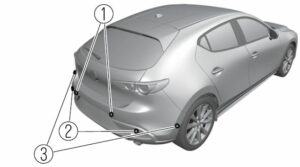
- Rear ultrasonic sensor
- Rear corner ultrasonic sensor
- Rear side ultrasonic sensor
The ultrasonic sensors are mounted in the rear bumper.
Front Camera/Side Cameras/Rear Camera
Front Camera/Side Cameras/Rear Camera Your vehicle is equipped with a front camera, side cameras, and a rear camera. The 360° View Monitor uses each camera. Refer to 360° View Monitor The front camera, side cameras, and rear camera shoot images of the area surrounding the vehicle. Each camera is installed to the following positions.
- Side cameras
- Front camera
- Rear camera
5–Door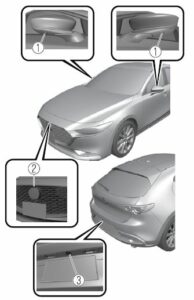
- Side cameras
- Front camera
- Rear camera
Driver Monitoring Camera
The driver monitoring camera detects changes in the driver’s facial features and estimates the amount of accumulated fatigue and sleepiness of the driver.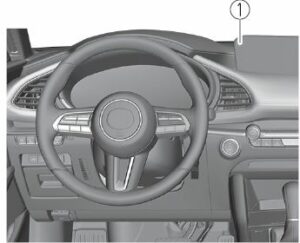
- Driver monitoring camera
NOTE
- Driver Monitoring (DM) and the earlier collision warning may not operate normally under the following conditions.
- The driver monitoring camera is covered with something.
- You are driving the vehicle while leaning on the steering wheel.
- You are wearing glasses or sunglasses.
- A cap or hat you are wearing partially blocks the driver monitoring camera’s view of your eyes, you have long bangs partially covering your eyes, or a part of your face is invisible due to a face mask.
- The lighting conditions change significantly (such as backlight, light from the side, or direct light from the setting sun, and the headlights of on-coming vehicles).
You are driving the vehicle with your head excessively tilted to one side or the other. - You are moving around extensively.
- Your face or your eyes frequently turn in direction other than straight ahead (direction of travel).
- Your line of sight moves or directly after it has moved.
- There is a large difference between your line of sight and the direction your face is pointed.
- You are driving the vehicle with your head largely tilted to one side.
FAQs
Radar sensors are used by the cutting-edge driver assistance technology known as radar cruise control to maintain a certain speed and separation from the vehicle in front of you.
The Mazda3’s Radar Cruise Control measures the distance and speed of the car in front of it using a front-mounted radar sensor. In order to maintain a safe following distance, the car’s speed is adjusted.
By automatically altering the vehicle’s speed to match traffic circumstances, radar cruise control lessens driver fatigue. Maintaining a safe distance from the car in front also improves safety.
Yes, the Mazda3’s Radar Cruise Control technology allows for adjustment of the following distance. You can manually adjust it to your preferences or select from a variety of preset distances.
The stop-and-go feature of the Mazda3’s Radar Cruise Control is true. When the traffic resumes moving, it can bring the car to a complete stop before continuing to follow the car in front.
Yes, the Mazda3’s Radar Cruise Control may be disabled or overridden by merely depressing the brake or accelerator pedal. The steering-wheel cancel button is another option.
Rain and fog don’t typically interfere with the performance of radar cruise control. Extreme weather or significant precipitation, however, might have an impact on how well it works.
Roads with mild curves and straight stretches of highway are the best places to deploy radar cruise control. On narrow, twisty routes, it could perform subparly.
Radar Cruise Control is not a replacement for careful driving. It is a driver-assistance feature, so the driver must still be vigilant and prepared to take over control of the car if necessary.
With radar cruise control, a specified speed limit can be established. You can program the device to keep your preferred cruising pace unless the driver changes it.
Up to the vehicle’s top speed, the Mazda3’s radar cruise control operates at speeds greater than about 19 mph (30 km/h). However, depending on the trim level and options, some functions could not be available at all.
Depending on the trim level and extras selected, radar cruise control is either a standard or optional feature. For precise availability, it is advised to speak with your local Mazda dealer or consult the vehicle’s specifications.
Useful Links
View Full User: 2021 Mazda3 User Manual | Auto User Guide
Download Link: Owner’s – Manuals, Guides, Maintenance Schedules | Mazda USA

